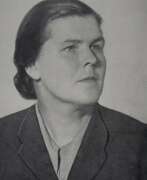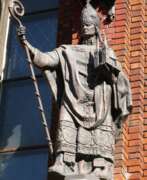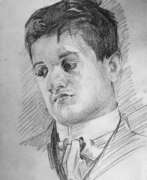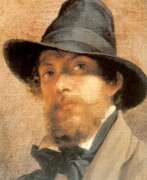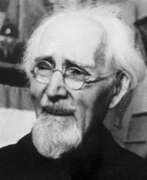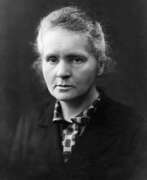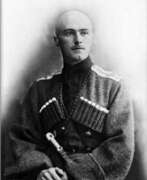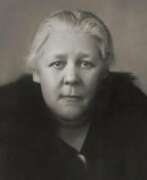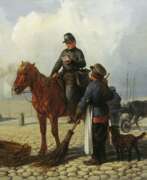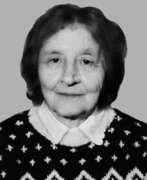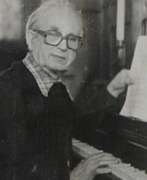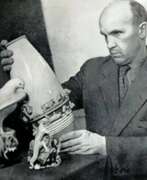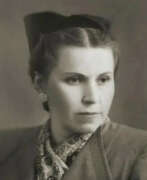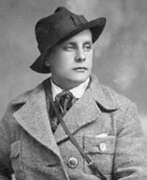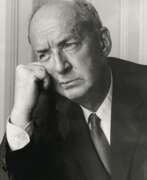Educators Russian Empire
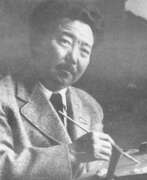

Gapar Aitievich Aitiev (Russian: Гапар Айтиевич Айтиев), a pioneering figure in Soviet Kyrgyz art, was born in 1912 and became a cornerstone of Kyrgyz cultural heritage through his impactful contributions as an artist and educator. Aitiev's journey in art began at the Moscow Art School in Memory of 1905, where he studied under N. P. Krymov between 1935 and 1938, laying the groundwork for his illustrious career. His profound connection to his Kyrgyz roots was reflected in his artwork, characterized by epic, poetic landscapes of Kyrgyzstan, such as "Midday on Issyk Kul" (1954), and detailed portraits like the "Gallery of portraits of contemporaries" (1979). Aitiev's contributions to the art world earned him the prestigious titles of People’s Artist of the USSR and Hero of Socialist Labor, marking his influence on Soviet and Kyrgyz art history.
The Gapar Aitiev Kyrgyz National Museum of Fine Arts, named in his honor, stands as a testament to his legacy, showcasing not only his work but also a broad spectrum of Kyrgyz and Russian art, spanning from traditional Kyrgyz artifacts to contemporary works post-independence. This museum, alongside the Gapar Aitiev Memorial Studio Museum in Bishkek, provides insight into Aitiev's life, offering a personal glance at his workspaces and the art that filled his surroundings. These institutions preserve and celebrate Aitiev's dedication to portraying the tranquil beauty of Kyrgyz landscapes and the spirit of its people, making his work an integral part of Kyrgyz national identity.
For those interested in the rich tapestry of Central Asian art, visiting these museums in Bishkek is a journey through the heart of Kyrgyz culture and history, brought alive by Aitiev's artistic vision. His work not only captures the essence of Kyrgyzstan's landscapes and people but also serves as a bridge between the traditional and the modern, embodying the nation's cultural evolution.
To stay updated on exhibitions and events celebrating Gapar Aitievich Aitiev's legacy and to explore more about his contributions to art and culture, consider signing up for updates. This subscription will keep you informed about new product sales and auction events dedicated to Aitiev's work, ensuring that enthusiasts and collectors alike remain connected to the vibrant world of Kyrgyz art.
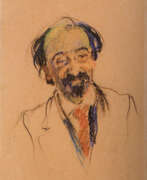

Manuel Khristoforovich Alajalov (Russian: Мануил Христофорович Аладжалов) was a prominent Russian and Soviet landscape painter and educator, born in 1862 in Nakhichevan-on-Don. Alajalov's work is distinguished by his exquisite landscapes that capture the essence of the Russian countryside. His paintings are noted for their masterful use of light and shadow, bringing a serene and lifelike quality to his depictions of nature.
Alajalov's career was marked by a deep commitment to portraying the natural world with authenticity and emotion. His art reflects a profound appreciation for the tranquility and beauty of rural Russia, making him a significant figure in the history of Russian art. Alajalov's legacy as a teacher also influenced many aspiring artists of his time, further cementing his place in the artistic community.
Alajalov's works are showcased in several major Russian museums, including the State Tretyakov Gallery, where art enthusiasts can experience his contribution to landscape painting. His paintings continue to be celebrated for their technical excellence and emotional depth, attracting collectors and admirers from around the world.
For updates on new product sales and auction events related to Manuel Khristoforovich Alajalov, sign up for our newsletter. Stay informed about exclusive opportunities to own a piece of this celebrated artist's legacy.
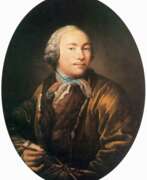

Ivan Petrovich Argunov (Russian: Иван Петрович Аргунов) was a distinguished Russian painter of the 18th century, celebrated for his significant contribution to portrait art. As a serf born into the Argunov family, who were established artists themselves, Ivan's talent was nurtured and supported by his patrons, leading to a unique position within the cultural and artistic hierarchies of his time. His specialization in portraiture allowed him to capture the essence of Russia's social elites, including members of the imperial family, as well as ordinary Russians, thereby providing a wide-ranging visual documentation of the era's societal strata.
Argunov's art is noted for its meticulous attention to detail, vibrant realism, and the emotional depth he brought to his subjects. His portraits are more than mere representations; they are intimate glimpses into the lives and characters of his sitters. Among his most famous works is the portrait of Princess Natalia Petrovna Golitsyna, showcased in the Tretyakov Gallery in Moscow. This particular piece stands out for its intricate portrayal of fabric textures and the detailed rendering of facial expressions, which have been lauded for their lifelike quality and depth.
Argunov's legacy extends beyond his artistic achievements; he played a pivotal role in shaping the course of Russian portraiture. His works are preserved in major museums and galleries across Russia, serving as a testament to his skill and the cultural richness of his time. For collectors and experts in art and antiques, Argunov's paintings are not just historical artifacts but are cherished for their aesthetic value and the insight they offer into 18th-century Russian culture.
We invite enthusiasts and collectors to stay connected with us for updates on new product sales and auction events related to Ivan Petrovich Argunov. By signing up, you will gain exclusive access to the finest pieces of Russian art and antiques, ensuring you never miss an opportunity to enrich your collection with works by one of Russia's most esteemed artists.
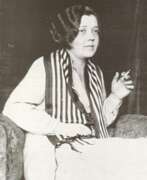

Zinaida Antonovna Astapovich-Bocharova (Russian: Зинаида Антоновна Астапович-Бочарова) was a Russian, Soviet and Belarusian artist of the twentieth century. She is known as a painter, graphic artist and teacher.
Zinaida Astapovich-Bocharova worked in the genres of portrait, landscape, propaganda poster, as well as book illustration - mainly for fairy tale books. She painted in watercolor, oil, pencil, charcoal, gouache, and pastel. Much of her work from the 1930s and 1940s was lost during the evacuation of the artist from besieged Leningrad.
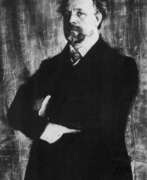

Vasily Nikolayevich Baksheyev (Russian: Василий Николаевич Бакшеев) was a distinguished Russian painter, celebrated for his contributions to landscape, interior, still life, and genre painting. His works are emblematic of the Union of Russian Artists' spirit, a movement he was closely aligned with throughout his career. Born in Moscow in 1862, Baksheyev was a prodigious talent who honed his craft at the esteemed Moscow School of Painting, Sculpture, and Architecture from 1877 to 1888, under the tutelage of luminaries such as Vladimir Makovsky, A. K. Savrasov, and V. D. Polenov. His artistic journey was marked by a significant award early on—a large silver medal for "The Return of Pilgrimage" in 1889—and travels to cultural hubs like Paris and Munich in 1895, which broadened his artistic horizons.
Baksheyev's artistry evolved over the years, from initial genre pictures to a profound exploration of landscape painting, for which he is most renowned. His works, especially from the Soviet era, continue the rich tradition of Russian lyrical landscape, imbued with a poetic quality that captures the essence of nature's transient beauty. His teaching career and efforts in organizing regional museums further underscore his commitment to art and community. Baksheyev's legacy is preserved in his poignant and luminous paintings, such as "Twilight," "Birches," and "Sunny Day," which offer a glimpse into the serene and vibrant landscapes of the Tarusa region. His work remains an invaluable part of Russia's cultural heritage, housed in numerous museums across the country and celebrated for its artistic integrity and emotional depth.
For art collectors and enthusiasts, Baksheyev's oeuvre represents a pivotal chapter in the evolution of Russian painting, characterized by its lyrical beauty and emotive power. His ability to blend impressionistic brushwork with symbolic imagery creates a unique visual language that speaks to the heart of the Russian landscape tradition.
To stay updated on new insights and opportunities related to Vasily Nikolayevich Baksheyev, including sales and auction events, signing up for updates is highly recommended. This subscription ensures that enthusiasts and collectors alike are always informed about the latest developments and available works related to this exceptional artist.
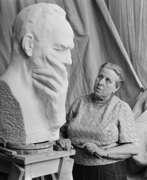

Ekaterina Feodorovna Belashova (Russian: Екатерина Фёдоровна Белашова) was a Russian sculptor renowned for her profound contributions to Soviet sculpture. Born in St. Petersburg in 1906, she later moved to Moscow to further her education and career. Belashova began her artistic journey at VKHUTEIN, studying under notable figures such as R. Bach and A. Matveev. Her career saw her become a revered professor at the Moscow Institute of Applied and Decorative Arts and the Moscow School of Industrial Arts.
Her works, celebrated for their delicate silhouettes and meticulous attention to proportions, delve into the emotional and physical resilience of individuals, particularly during the turbulent times of war. Belashova's sculptures often embody the spirit of her era, exploring themes of loss, hope, and the enduring strength of the human spirit. Notable works include "The Fighter," "Unvanquished," and a series dedicated to the memory of the victims of fascism, showcasing her ability to capture the essence of her subjects with both sensitivity and strength.
Belashova's sculpture, "Girl with a garland in her hair," exemplifies her skill in capturing youth and vitality, showcasing a young girl in a moment of introspection and grace. This piece highlights Belashova's mastery over bronze, a material she often utilized despite its scarcity in the post-war period.
Throughout her life, Belashova remained deeply connected to the art world, not only through her creations but also as an educator and influencer in the Soviet art scene. Her contributions were recognized with numerous awards, including the prestigious State Prize of the USSR. Belashova's legacy is one of artistic excellence and profound humanity, leaving an indelible mark on the world of sculpture.
For collectors and experts in art and antiques, Ekaterina Feodorovna Belashova's work offers a deep dive into the rich tapestry of Soviet-era sculpture, characterized by its emotional depth and aesthetic finesse. Sign up for updates on new product sales and auction events related to Ekaterina Feodorovna Belashova, and explore the enduring beauty of her contributions to the world of art.
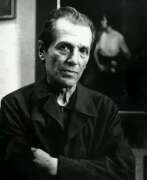

Piotr Petrovich Belousov (Russian: Пётр Петро́вич Белоу́сов) was a distinguished Soviet and Russian artist, born on May 3, 1912, in Berdyansk, and passed away on March 31, 1989, in Leningrad. He is widely celebrated for his contributions to the Leningrad School of Painting, having been an influential figure in shaping the artistic landscape of the region. His expertise extended across various mediums, including painting, etching, and graphic arts, with a notable focus on themes like the Bolshevik Revolution and historical Soviet figures like Lenin.
Belousov's educational and professional journey was deeply intertwined with the prestigious Ilya Repin Leningrad Institute of Painting, Sculpture and Architecture, where he both studied and later taught, eventually rising to the rank of professor and head of the drawing department by 1956. His career was marked by numerous accolades, including the titles of Honored Artist and People's Artist of the RSFSR, reflecting his significant impact on Russian art and education.
Throughout his life, Belousov participated in many exhibitions and his works are held in high esteem, not only in Russian state museums like the Russian Museum and the Tretyakov Gallery but also internationally. His pieces, particularly those that capture key moments in Soviet history and urban landscapes, remain influential and are sought after by collectors around the worl.
For enthusiasts of Soviet art and collectors interested in Belousov's works, staying updated on exhibitions and sales can provide valuable opportunities to acquire his art. To receive alerts about new product sales and auction events featuring Piotr Petrovich Belousov's works, signing up for updates is highly recommended.
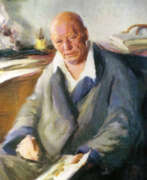

Pavel Petrovich Benkov (Russian: Павел Петрович Беньков) was a Russian and Soviet artist of the first half of the twentieth century. He is known as a painter, graphic artist, theater decorator, and teacher.
Pavel Benkov created portraits, landscapes, cityscapes, genre paintings. His style in his mature years can be described as impressionist, with attention to color and light. In 1929 he moved to Central Asia, where his style took on unique characteristics, reflecting local landscapes and culture. His work has had a significant influence on the painting traditions of Uzbekistan and Central Asia.
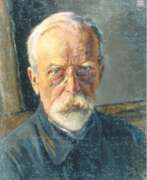

Yulii Yulyevich Blumenthal (Russian: Юлий Юльевич Блюменталь) was a Russian and Soviet artist of the first half of the twentieth century of German origin. He is known as a painter and graphic artist who played an important role in the development of Bashkir fine arts.
Yulii Blumenthal created portraits, landscapes and genre works, including those reflecting the culture and life of the Bashkir people, such as "Bashkir Rider" and "Behind Shearing Sheep". Being the director of the Bashkir State Art Museum in 1926-1935, the master played a significant role in laying the foundations of professional museum accounting and documentation.
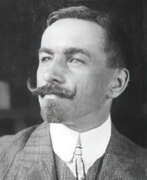

Grigory Mikhailovich Bobrovsky (Russian: Григорий Михайлович Бобровский) was a distinguished Russian painter born in Vitebsk in 1873 and passed away in Leningrad in 1942. His academic journey in the arts began at the prestigious Academy of Arts under the tutelage of Ilya Repin between 1893 and 1900, where he honed his craft and graduated with the title of artist for his painting "Evening." By 1916, Bobrovsky was recognized as an academician, contributing significantly to the Russian art scene with his evocative landscapes and scenes capturing early 20th-century life.
Bobrovsky's artwork is celebrated for its free manner of painting, decorative expressiveness of color, attention to lighting effects, and the fragmentariness of composition. His works, which were influenced by both the Union of Russian Artists and the Mir Iskusstva movement, spanned a variety of themes, including landscapes and scenes dedicated to the Revolution and life in the USSR. Notable works include "Early Spring" (1922), "Night at Sea" (1923), and "The Road" (1927), showcasing his mastery over light and color.
His contributions to Russian art were recognized through exhibitions during his lifetime and posthumously, with retrospective exhibitions held in Leningrad (1947) and Perm (2001). Bobrovsky's works are part of several prestigious collections, including the State Tretyakov Gallery, the State Russian Museum, and the Perm State Art Gallery, evidencing his lasting impact on the art world.
For art collectors and experts, Grigory Mikhailovich Bobrovsky's oeuvre offers a profound insight into the evolution of Russian painting in the early 20th century. His ability to capture the essence of his era through vibrant colors and expressive compositions makes his work a valuable addition to any collection.
To stay updated on new product sales and auction events related to Grigory Mikhailovich Bobrovsky's works, sign up for updates. This subscription will keep you informed about opportunities to acquire pieces by this remarkable artist, ensuring you don't miss out on adding a piece of Russian art history to your collection.
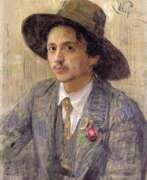

Isaak Israelievich Brodsky (Russian: Исаак Израилевич Бродский), a distinguished Russian artist, was renowned for his contributions to painting and teaching. Born in Sofievka, Russian Empire, Brodsky's artistic journey led him to become a pivotal figure in the Soviet art scene, primarily recognized for his realistic portraits and social realist works. His dedication to capturing the essence of his subjects, combined with a unique sensitivity to color and form, allowed his art to transcend mere representation, offering insights into the culture and political climate of his time.
Throughout his career, Brodsky was closely associated with significant cultural and political developments in Soviet Russia, becoming an official artist of the Soviet regime. His works, such as the iconic portraits of Lenin and other political figures, not only exemplify his skill but also serve as historical documents, offering a glimpse into the era's social fabric. His commitment to realism and the portrayal of Soviet ideals earned him a prominent place in the art world, influencing generations of artists through his role as a teacher and mentor at the Repin Institute of Arts.
Brodsky's legacy is preserved in numerous museums and galleries, with his masterpieces forming an integral part of Russia's cultural heritage. His ability to intertwine art with historical narrative has made his work a subject of study for art collectors and experts alike. For those intrigued by the depth and historical significance of Soviet art, Brodsky's oeuvre offers a fascinating exploration into the power of visual storytelling.
For collectors and experts keen on delving deeper into the rich tapestry of Russian art, staying informed about Isaac Israelievich Brodsky's work is essential. Signing up for updates ensures exclusive access to news on product sales and auction events dedicated to Brodsky's art, providing a unique opportunity to engage with the history and culture he so vividly depicted. Join us in celebrating the legacy of a true maestro of painting, whose works continue to inspire and captivate audiences worldwide.
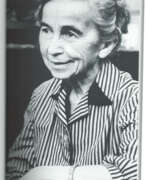

Varvara Dmitrievna Bubnova (Russian: Варвара Дмитриевна Бубнова) was a distinguished Russian painter, graphic artist, and pedagogue, celebrated for her mastery in lithography. Born into a noble family in St. Petersburg, she was deeply immersed in an atmosphere of poetry and music from an early age, which significantly influenced her artistic and intellectual development. Bubnova's education spanned from the Drawing School of the Society for the Encouragement of Arts to the St. Petersburg Academy of Arts, where she was an active member of the avant-garde group "Union of Youth" alongside prominent figures like Mayakovsky, Malevich, and Goncharova.
Her journey took a dramatic turn in 1923 when she moved to Japan, marking the beginning of a transformative period where she not only embraced Japanese art forms like suibokuga and Sumi-E ink drawing techniques but also significantly contributed to Japanese cultural life through her work and teachings. Her unique approach to art and education left a lasting impact on Japanese arts and culture. Among her notable works inspired by her experiences in Japan are "Young Violinist" (1942) and "Village Street. Japan" (1953), showcasing her fascination with Japanese life and aesthetics.
The later years of her life were spent in Sukhum, Abkhazia, where she continued to create vibrant and expressive works, demonstrating a remarkable adaptability and evolution of her artistic style throughout her life. Her works from this period, such as "Behind the Green Door" (1972), highlight her ongoing exploration of color and form. Bubnova's legacy extends beyond her artworks, as she played a crucial role in promoting Russian literature in Japan, contributing to a deeper understanding and appreciation of Russian culture among Japanese audiences.
Bubnova's artworks are part of major collections domestically and internationally, showcasing her diverse talent across various mediums and subjects. Her influence on both Russian and Japanese art scenes underscores her position as a bridge between cultures, celebrated for her artistic innovations and cross-cultural contributions.
For collectors and experts in art and antiques, Varvara Dmitrievna Bubnova's works represent a unique fusion of Russian avant-garde principles with Japanese artistic traditions, making her a fascinating figure whose pieces are a testament to a life spent transcending cultural boundaries. To stay updated on new sales and auction events related to Varvara Dmitrievna Bubnova's works, sign up for updates and immerse yourself in the legacy of this extraordinary artist who effortlessly blended the best of two worlds.


Fyodor Fyodorovich Buchholz (Russian: Фёдор Фёдорович Бухгольц) was a Russian artist of German origin in the late 19th century and the first half of the 20th century. He is known as a painter, graphic artist and teacher.
Fyodor Buchholz painted mainly on historical themes and genre paintings, as well as portraits and landscapes. At the end of the XIX century, the artist was fascinated by Art Nouveau. After the revolution of 1917 he began to create works on the themes of social construction.
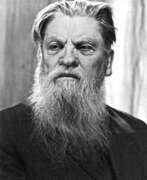

Piotr Dmitrievich Buchkin (Russian: Пётр Дмитриевич Бучкин) was a multifaceted Soviet and Russian artist known for his contributions to painting, graphic arts, and teaching. Educated at the Higher Art School at the Imperial Academy of Fine Arts under Vasiliy Mate and Vasily Savinsky, Piotr Buchkin graduated in 1912, embarking on a journey that included travels across Europe to refine his artistry. His works span a variety of genres, including portraits, genre paintings, landscapes, and illustrations, showcasing his versatility across different mediums such as watercolor, pencil, pastels, etchings, oil, and tempera paintings.
Piotr Buchkin's engagement with the art world was profound; he was a founding member of the Leningrad Union of Artists and contributed significantly to the Leningrad School of Painting. Throughout his career, Buchkin participated in numerous exhibitions and was recognized for his talent as a graphic artist and portraitist, adept in various painting techniques. His memoirs, "About that in memory: Notes of an Artist," provide insights into his artistic journey and experiences.
Piotr Dmitrievich Buchkin's works are held in prestigious collections, including the State Russian Museum and the State Tretyakov Gallery, reflecting his esteemed position in the art community. His legacy continues to inspire, as his works are found not only in Russia but also in private collections and museums worldwide.
For collectors and experts in art and antiques, Piotr Buchkin's oeuvre offers a deep dive into the richness of Soviet and Russian art, particularly the Leningrad School. To stay updated on exhibitions, sales, or auctions featuring Buchkin's works, consider subscribing to relevant updates.
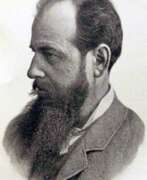

Joseph-Casimir Konstantinovich Budkevich (Russian: Иосиф-Казимир Константинович Будкевич) was a Ukrainian painter and draftsman, born on April 18, 1841, in Kyiv. Known for his battle scenes and landscapes, Budkevich studied at the Imperial Academy of Arts in Saint Petersburg, where he received several medals for his works. In 1873, he was awarded the title of Class Artist 3rd Degree.
Budkevich traveled to Italy, France, Spain, and Palestine to refine his skills. In the late 1870s and 1880s, he taught at the Kyiv Drawing School, where one of his students was Mykola Pymonenko. From 1887 to 1895, he was a member of the Kyiv Society of Art Exhibitions.
Among his notable works are "Pilgrim at the Monastery Wall" (1883) and "Jerusalem" (1894). These paintings are exhibited at the Kyiv Museum of Russian Art and the Pskov Art Gallery. His work is highly valued by collectors and art experts for its uniqueness and mastery.
If you want to receive notifications about new arrivals and auctions related to Joseph-Casimir Budkevich's work, subscribe to our updates. We will keep you informed about new sales and events related to his legacy.
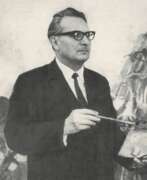

Alexander Gavrilovich Budnikov (Russian: Александр Гаврилович Будников) was a Soviet Ukrainian artist of the twentieth century. He is known as a battle painter.
During the Great Patriotic War Alexander Budnikov worked for a frontline newspaper, created posters and sketches from the battlefields. After the war he studied at the Kiev Art Institute, later became a teacher and professor at this institution. The artist worked in the genre of battle painting, and was also the author of a series of landscapes from different countries. His works are kept in museums in Ukraine, Russia and in private collections in Europe, the USA and Canada.
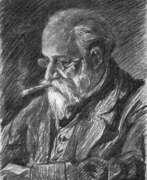

Adolf Iosifovich Charlemagne (Russian: Адольф Иосифович Шарлемань) was a renowned Russian painter, born in 1826 in Saint Petersburg. He excelled in historical, genre, and battle scenes, deeply influenced by his artistic lineage—his father was an architect and his grandfather a sculptor. Educated at the Imperial Academy of Arts under Fyodor Bruni and Bogdan Willewalde, Charlemagne's works are celebrated for their historical accuracy and intricate details.
Charlemagne's notable works include "The Capture of Kazan by Ivan the Terrible" and "The Battle of Kulikovo," which vividly capture significant moments in Russian history. His paintings are known for their meticulous attention to detail, dramatic compositions, and ability to convey the emotional intensity of historical events. These masterpieces are housed in prestigious Russian museums, showcasing his contributions to Russian cultural heritage.
Throughout his career, Charlemagne received numerous accolades, including the titles of Academician and Professor at the Imperial Academy of Arts. His dedication to historical accuracy and artistic excellence made him a prominent figure in Russian art.
For collectors and enthusiasts, owning a piece by Adolf Iosifovich Charlemagne means acquiring a significant part of Russian history. To stay updated on new product sales and auction events related to Charlemagne's works, sign up for our updates today.
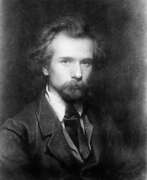

Pavel Petrovich Chistyakov (Russian: Павел Петрович Чистяков) was a renowned Russian painter and teacher, celebrated for his significant influence on the Russian art scene. Born in 1832, Chistyakov is recognized for his pivotal role in shaping the techniques and philosophies of many prominent Russian artists. His work and teachings emphasized the importance of academic discipline, thoroughness in the study of nature, and the detailed analysis of historical and classical art. Chistyakov's approach to art education has left a lasting legacy, fostering a generation of artists who would define Russian culture and art for years to come.
Chistyakov’s pedagogical methods and artistic contributions were characterized by a rigorous focus on drawing, anatomy, and perspective, which became foundational for the development of Russian realist art. He taught at the Imperial Academy of Arts in Saint Petersburg, where his students included illustrious names like Ilya Repin, Valentin Serov, and Vasily Surikov. These artists went on to become leading figures in the Russian art world, a testament to Chistyakov's influence and the effectiveness of his teaching methods.
Beyond his teaching, Chistyakov's own works are celebrated for their depth and mastery of form and composition. Although less known internationally than his students', his paintings and sketches hold significant value and are housed in prestigious museums, reflecting the cultural heritage of Russia. For collectors and experts in art and antiques, Chistyakov's legacy represents an era of transformation in Russian art, making his works highly sought after. His contributions to art education and the development of a uniquely Russian artistic identity cannot be overstated.
For those intrigued by the rich tapestry of Russian art and culture, staying informed about Pavel Petrovich Chistyakov’s works is essential. We invite collectors and art enthusiasts to sign up for updates on new product sales and auction events related to Chistyakov. This subscription ensures you remain at the forefront of significant developments and opportunities to acquire pieces linked to this pivotal figure in Russian art history. Join us in exploring and celebrating the legacy of Pavel Petrovich Chistyakov.
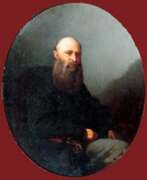

Romuald Chojnacki was a mid-nineteenth-century Russian artist of Polish descent. He is known as a painter and teacher.
Romuald Chojnacki was a follower of the Italian school of painting. He worked mainly in portrait and religious genres. At the beginning of his career, he also created historical paintings and returned to this genre shortly before his death.
The master was one of the founders of the Odessa Drawing School. Among his pupils was the famous Polish artist Stanisław Chlebowski.


Semyon Afanasyevich Chuikov (Russian: Семён Афанасьевич Чуйков) was a seminal figure in the art world, bridging cultures and epochs with his unique blend of realism and vibrant colorism. Born on October 17, 1902, in Bishkek, then part of the Russian Empire, Chuikov emerged as a pioneering artist whose works deeply influenced the national school of Kyrgyzstan painting. His contributions were not confined to the canvas; he was instrumental in establishing the museum of fine arts and the first art school in Kyrgyzstan, showcasing his commitment to fostering artistic growth in the region.
Chuikov's artistry was profoundly influenced by his experiences and travels. His style, initially reminiscent of the Russian avant-garde group Jack of Diamonds, evolved to incorporate elements from his travels to India, Italy, France, Greece, and Bulgaria. This worldly exposure enriched his color palette and thematic focus, enabling him to capture the essence of Kyrgyz and Indian life with an impressive honesty and emotional depth. His work, particularly the series from India, stood out for its vivid portrayal of the common people's lives, earning him the prestigious Jawaharlal Nehru Award in 1967.
His legacy extends beyond his paintings, with his works residing in esteemed collections worldwide, including the State Tretyakov Gallery, the State Museum of Oriental Art, and the Museum of Fine Arts of Kyrgyzstan, among others. Chuikov was also a revered educator, nurturing the talents of students who would go on to become celebrated artists themselves.
For collectors and art and antiques experts, Chuikov's work represents a unique investment in cultural heritage and artistic brilliance. His ability to intertwine Kyrgyz traditions with broader artistic movements makes his work particularly appealing for those interested in the cross-cultural exchange of art.
For updates related to Semyon Afanasyevich Chuikov, including new product sales and auction events, sign up for our newsletter. Stay informed about opportunities to acquire pieces of his enduring legacy.


Jan Ciągliński (Russian: Ян Францевич Ционглинский), a Polish Impressionist painter established in Russia, was born into a noble family in Warsaw on February 20, 1858, and died on January 6, 1913, in Saint Petersburg. He studied at the University of Warsaw before moving to Saint Petersburg in 1879, where he furthered his education at the Imperial Academy of Arts. Ciągliński was a pivotal figure in the Russian art scene, recognized as one of the first Russian Impressionists. His success in Russia was significant, though he remained less known in his native Poland.
Ciągliński's art was inspired by his travels across Europe, North Africa, and the Middle East, painting landscapes, often with oriental themes, symbolic images, figure compositions, decorations, and portraits. He was celebrated for his color work and the way he captured light. Among his notable students were Ivan Bilibin, Viktor Vesnine, Mikhail Matiushin, Pavel Filonov, and Yelena Guro, highlighting his influential role as an educator. Ciągliński was also one of the founders of "Mir Iskusstva" (World of Art), contributing significantly to its development.
Some of Ciągliński's works can be found in museums across Poland and Ukraine, a testament to his last will to donate his oeuvre to his homeland. His legacy is reflected in his diverse body of work that includes portraits of famous musicians such as Pyotr Tchaikovsky, Sergei Rachmaninoff, and Frederic Chopin, showcasing his connection to the music world.
For collectors and art and antiques experts interested in the intersection of Polish heritage and Russian Impressionism, Jan Ciągliński's work represents a fascinating study. Sign up for updates on new product sales and auction events related to Jan Ciągliński to explore more about this distinguished artist's contributions to the art world.
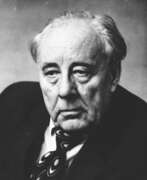

Mykhailo Hordiiovych Derehus (Russian: Михаил Гордеевич Дерегус) was a prominent Soviet Ukrainian graphic artist, painter, and educator, renowned for his significant contributions to the visual arts in Ukraine. Born on December 5, 1904, in Veseloye, Kharkiv Oblast, Derehus' artistic journey began at the Kharkiv Art Institute, where he not only honed his skills but also later imparted knowledge as a lecturer. His diverse body of work spans thematic painting, landscapes, still lifes, portraiture, etching, and book illustration, demonstrating his versatility across different mediums.
Derehus' art, particularly his expressionist lithographs, played a crucial role in illustrating significant Ukrainian literary works, such as Ivan Kotliarevsky's "Eneïda" and the writings of Nikolai Gogol, Lesya Ukrainka, Marko Vovchok, and Natan Rybak. His illustrations are celebrated for their depth and ability to capture the essence of the Ukrainian spirit. A testament to his mastery and significant impact on Ukrainian art, Derehus was awarded the prestigious Shevchenko National Prize in 1969. His legacy includes his leadership as Chairman of the National Union of Artists of Ukraine from 1955 to 1962 and his works being held in esteemed collections such as the Kuindzhi Art Museum in Mariupol, Ukraine.
For collectors and experts in art and antiques, Derehus' work represents a vital link in the chain of Ukrainian cultural heritage, offering unique insights into the nation's artistic evolution. His contributions have not only enriched Ukrainian visual arts but also ensured that the beauty of Ukraine's landscapes, its historical narratives, and the richness of its folklore continue to inspire future generations.
If you're intrigued by the artistic legacy of Mykhailo Derehus and wish to explore more about his works and their significance in the realm of Ukrainian art, consider signing up for updates. This subscription will keep you informed about new product sales and auction events related to Derehus, offering exclusive opportunities to connect with the rich tapestry of Ukrainian cultural expression.
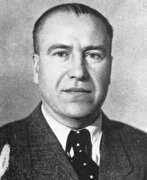

Aleksandr Aleksandrovich Deyneka (Russian: Алекса́ндр Алекса́ндрович Дейне́ка) was a Soviet Russian artist, celebrated for his significant contribution to the world of modernist figurative painting in the first half of the 20th century. Born into a Ukrainian origin, Deyneka's artistry spanned painting, graphic design, and sculpture, leaving an indelible mark on Russian modernism. His works, characterized by vivid movement and an innovative portrayal of the Soviet lifestyle, include iconic pieces such as "The Defense of Sevastopol," "Collective Farmer on a Bicycle," and "Future Pilots," which showcase the dynamism and spirit of the Soviet era. Deyneka's commitment to Social Realism—a style aimed at the accessible portrayal of everyday life—earned him both national and international acclaim. His murals and mosaics for public buildings and metro stations in Moscow, like the Mayakovskaya station, underline his influence on the Soviet visual landscape and contribute to his legacy as a pioneer of a style that bridged European innovation with Soviet themes.
Deyneka's journey began with his education at the VHUTEMAS, where he was influenced by figures such as Mayakovsky, which shaped his approach to art as a tool for societal influence and expression. His artworks, permeated with themes of labor, sports, and a forward-looking optimism, reflect the Soviet Union's utopian ambitions and the complexities of its societal structure. Notably, Deyneka's "Mother" stands out as a powerful symbol of the Soviet woman, intertwining high social awareness with the natural role of motherhood, highlighting the artist's nuanced approach to depicting Soviet life.
Throughout his career, Deyneka remained a formidable figure in art, navigating through various artistic societies and contributing to magazines and posters that defined the visual narrative of the Soviet Union. His travels to Italy, France, and the US broadened his perspective, enriching his work with international influences while retaining his distinct stylistic identity. Deyneka's decorations for the Moscow Metro not only won prestigious awards but also immortalized his vision of Soviet progress and optimism, capturing the essence of an era poised between grand aspirations and complex realities.
For art collectors and enthusiasts of Russian modernism, Deyneka's works offer a window into the vibrancy and ideological fervor of the Soviet Union, embodying the era's aesthetic and thematic aspirations. His contributions to the public and artistic spheres underscore the role of art in shaping and reflecting societal values, making his oeuvre a vital point of study for anyone interested in the intersections of art, history, and society.
To stay informed about exhibitions and auctions featuring Aleksandr Aleksandrovich Deyneka's work, sign up for updates. This subscription ensures you're always in the know about new sales and events related to this iconic artist, allowing you to deepen your appreciation and possibly enhance your collection.
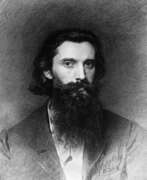

Nikolai Dmitrievich Dmitriev-Orenburgsky (Russian: Николай Дмитриевич Дмитриев-Оренбургский) was a Russian painter born in 1837 in Nizhny Novgorod. He is renowned for his battle scenes and depictions of Russian village life. Dmitriev-Orenburgsky studied at the Imperial Academy of Arts in St. Petersburg, where he was part of the ‘revolt of fourteen’—a group of students who challenged the conservative academic traditions of their time.
Dmitriev-Orenburgsky's work often reflected the harsh realities of rural Russian life, with a notable melancholic undertone even in his more cheerful scenes. His involvement in the Russo-Turkish War (1877-78) profoundly influenced his art, leading to several acclaimed battle paintings. Some of his significant works include "General M. D. Skobelev on his Horse" and "Siege of Plevna," which are housed in prestigious collections such as the Hermitage Museum and the Russian Museum.
His genre paintings, like "Sunday in a Village" and "Fire in a Village," capture the essence of Russian peasant life with striking realism and emotional depth. Dmitriev-Orenburgsky's legacy is celebrated for its historical significance and artistic excellence, making his works highly sought after by collectors and exhibited in major galleries worldwide.
Stay informed about upcoming sales and auctions featuring works by Nikolai Dmitrievich Dmitriev-Orenburgsky by signing up for our updates. Subscribe now to receive alerts on new product sales and auction events related to this distinguished artist.
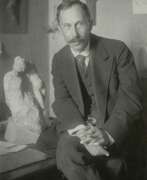

Vladimir Nicholaevich Domogatsky (Russian: Владимир Николаевич Домогацкий) was a Russian sculptor, teacher, and Honored Art Worker of the RSFSR, known for his contribution to the development of Soviet sculpture. Born in Odessa in 1876 and spending his early years in Switzerland and Ukraine, Domogatsky's life and career were predominantly centered in Moscow. He studied law at Moscow University and then took up sculpture under the tutelage of S.M. Volnukhin and S.V. Ivanov. Domogatsky's work was greatly influenced by the works of P. P. Trubetskiy, Auguste Rodin, the animalist painter R. Bugatti and others. Travels to Paris and Italy contributed to the improvement of his skills, especially in working with marble.
Domogatsky's work was diverse: genre, animalistic and portrait sculpture. Notable works include Boy in a Coat (1904), Portrait of an Old Actor (1913), and Portrait of Lev Shestov (1917), demonstrating his skill in merging Russian sculptural traditions with Western European influences. Teaching at the Moscow Institute of Fine Arts, organizing and participating in exhibitions all attest to his significant influence on the Soviet art scene. His works are held in prestigious museums, including the State Tretyakov Gallery, reflecting his enduring legacy in Russian art.
For collectors and experts, Domogatsky's sculptures represent a unique combination of historical and cultural narrative, embodied in the subtlety of his craftsmanship. His contributions to monumental propaganda and theoretical developments in sculpture further cement his status as a key figure in 20th century Soviet art.
To keep abreast of exhibitions and auctions featuring works by Vladimir Nikolayevich Domogatsky, we encourage you to subscribe to our updates. By subscribing, you will be the first to know about new sales and auction events related to this esteemed artist and enrich your collection with items of significant historical and artistic value.
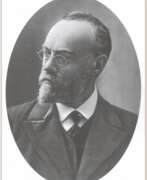

Nikolay Nikanorovich Dubovskoy (Russian: Николай Никанорович Дубовской) was a distinguished Russian landscape painter, renowned for his significant contributions to the "Landscape of Mood" movement alongside Isaac Levitan. Born into a Don Cossack family in Novocherkassk in 1859, Dubovskoy demonstrated artistic talent from an early age, initially encouraged by his uncle A.V. Pyshkin. Despite his father's initial insistence on a military career, Dubovskoy pursued his passion for art, studying under Mikhail Clodt at the Imperial Academy of Arts and later refusing a conventional academic path to instead exhibit with the Imperial Society for the Encouragement of the Arts. His work, "Winter," gained him early recognition when acquired by the Tretyakov Gallery in 1884.
Dubovskoy's legacy includes several masterpieces, such as "After the Rain," a beautiful example of his mature period that demonstrates the influence of French Impressionism, with its open composition and luminous treatment of light. This piece and others underline his mastery in capturing the nuanced interplay of light and atmosphere, resonating with both the Impressionist and Itinerant movements. Unfortunately, the distribution of his works across various museums after his death and the Soviet Union's collapse has made accessing his complete oeuvre challenging, requiring a journey across multiple countries.
Dubovskoy's contributions to Russian landscape painting and his unique ability to evoke mood and atmosphere in his works have cemented his place among the greats of the art world. His paintings, such as "The Calm Evening," praised as a "poem in gold" by critics, demonstrate his exceptional skill in rendering the delicate interplay of light and color. For those interested in exploring the depths of Russian landscape painting, Nikolay Nikanorovich Dubovskoy's works offer a rich and emotive experience, embodying the spirit of an era and the beauty of the Russian landscape.
To stay updated on sales and auction events featuring works by Nikolay Nikanorovich Dubovskoy, sign up for our updates. This subscription will ensure you're informed about new opportunities to appreciate and acquire pieces by this illustrious artist, focusing solely on relevant product sales and auction events.
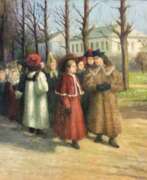

Ivan Osipovich Dudin (Russian: Иван Осипович Дудин) was a Russian and Soviet artist, painter, translator, and educator. He was born on January 19, 1867, in Moscow and passed away on April 4, 1924, in the same city. Dudin received his education at Moscow University and the Moscow School of Painting, Sculpture, and Architecture, where he was awarded the title of class artist in 1902.
Dudin is known for his landscapes, portraits, and genre scenes. His extensive travels influenced his works significantly. Since 1894, he regularly participated in exhibitions of the Moscow Society of Art Lovers and the Association of Traveling Art Exhibitions. Among his notable students were famous artists such as A.V. Kuprin, V.A. Favorsky, and V.I. Mukhina.
One of Dudin's significant works is "Blooming Garden" from 1902, which is exhibited in the State Tretyakov Gallery. His works can also be found in museums in Irkutsk, Kirov, and Krasnodar.
If you want to receive updates on new sales and auction events related to Ivan Osipovich Dudin, sign up for our updates. We will inform you only about new arrivals and events related to this artist.
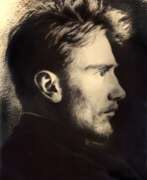

Grigory Kononovich Dyadchenko (Russian: Григорий Кононович Дядченко) was a Ukrainian artist and educator, born on October 8, 1869, in Kirilovka. Known for his landscape and portrait paintings, Dyadchenko's work embodies the realism movement. He studied at the Kyiv Drawing School and later graduated from the Imperial Academy of Arts in St. Petersburg, where he earned multiple awards.
Dyadchenko's artistry is evident in his poetic landscapes such as "Evening on the Dnieper" and "Kiev. View of Podil," which are characterized by their atmospheric depth and emotional resonance. His portraits, including "Head of a Girl" and the depiction of sculptor F. Balavensky, are celebrated for their psychological insight.
Dyadchenko also contributed to art education by teaching at the Kyiv Drawing School, influencing future artists like Mykhailo Kozyk and Vasyl Sylvestrov. His works are preserved in the National Art Museum of Ukraine and other prominent collections.
For those interested in Dyadchenko's art, sign up for updates on new product sales and auction events related to his masterpieces.
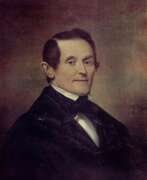

Johann Leberecht Eggink (Russian: Иван Егорович Эггинк) was a German-Baltic and Russian artist of the first half of the 19th century. He is known as a painter and teacher.
Johann Eggink lived and worked in the Russian Empire for some 40 years. He was mainly engaged in historical painting, creating paintings with subjects from a variety of eras, including ancient Rome and ancient Russia. The artist was also famous for his portraits and portrait miniatures. He received the title of Academician of the Imperial Academy of Arts in St. Petersburg.
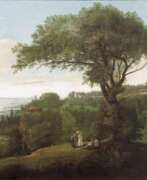

Yermolai Ivanovich Esakov (Russian: Ермолай Иванович Есаков) was a Russian painter, renowned for his landscape and battle scenes. Born in 1790, Esakov studied at the Imperial Academy of Arts under M. M. Ivanov and graduated in 1809. He gained recognition for his painting "Waterfall in a Mountainous Area," which earned him a gold medal and a position as a pensioner at the Academy.
Esakov worked as a domestic artist for the Stroganov family from 1810 to 1824. During this period, he accompanied Count P. A. Stroganov to Moldova during the Russo-Turkish War, where he painted "Russian Camp near Silistra." This work earned him the title of Academician at the Imperial Academy of Arts.
Esakov's paintings are characterized by their detailed representation of nature and historical events, showcasing his skill in capturing both the serene and the dramatic. His works are housed in various Russian museums, continuing to attract art lovers and collectors.
Stay informed about new product sales and auction events related to Yermolai Ivanovich Esakov by signing up for our updates.
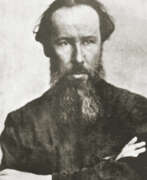

Vladimir Andreyevich Favorsky (Russian: Владимир Андреевич Фаворский) was a distinguished Russian artist and educator, renowned for his profound contributions to the realms of printmaking, illustration, and theory of art. Born into a milieu rich in culture and intellectual pursuit, Favorsky's work transcended the conventional boundaries of art, integrating elements of sculpture, painting, and graphic design, thereby redefining the aesthetic parameters of his time.
Favorsky's artistic philosophy was grounded in the belief that art should be a reflection of reality, yet imbued with the artist's personal vision and inner world. This approach led him to explore various mediums, yet he is most celebrated for his woodcuts and book illustrations. His ability to blend classical techniques with innovative narratives made his works timeless, appealing to collectors and art enthusiasts alike. Favorsky's contributions were not confined to his own creations; as a revered educator at the Moscow Printing Institute, he influenced generations of artists, instilling in them a deep appreciation for the cultural and historical significance of art.
Among his notable works, Favorsky's illustrations for classics of Russian literature stand out, capturing the essence of the narratives with striking visual imagery. While specific pieces in museums or galleries could not be verified without current research, his influence permeates the Russian art scene, with his works held in high esteem by collectors around the globe.
For collectors and experts in art and antiques, Favorsky's oeuvre represents a bridge between traditional and modern artistic expressions, offering a rich tapestry of themes and techniques to explore. His legacy continues to inspire, serving as a testament to the enduring power of artistic innovation and vision.
For enthusiasts eager to delve deeper into Favorsky's world, we invite you to sign up for updates. This subscription ensures you're the first to know about new product sales and auction events related to Vladimir Andreyevich Favorsky, without overwhelming your inbox. Embrace the opportunity to enhance your collection with pieces from a master of Russian art and culture.
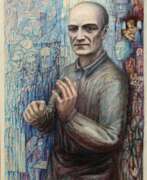

Pavel Nikolayevich Filonov (Russian: Павел Николаевич Филонов) was a distinguished Russian avant-garde painter, known for his unique approach to art and his profound influence on the culture of painting. Born in 1883, Filonov dedicated his life to developing a method he termed "Analytical Art," aiming to dissect and represent the inner dynamics of the visible world. His commitment to detail and a philosophy that art should be "made by all, for all" set him apart from his contemporaries.
Filonov's work is celebrated for its intricate texture and complex compositions, embodying a meticulous technique that captures the essence of his subjects. Unlike other artists of his time, Filonov refused to sell his artwork, believing it was a collective treasure that should benefit society. This idealism contributed to his relative obscurity during his lifetime, but posthumously, his oeuvre has been recognized for its visionary qualities. Notable works like "The Formula of the Petrograd Proletariat" exhibited at the Russian Museum in Saint Petersburg showcase his mastery and ideological commitment to art.
Filonov's legacy is a testament to his relentless pursuit of an artistic vision that was both revolutionary and deeply humanistic. His works, housed in prestigious museums and galleries, continue to inspire art collectors and experts, offering a window into the radical experiments of early 20th-century Russian art.
For those intrigued by Filonov's unique perspective and contributions to the art world, staying informed about upcoming exhibitions, sales, and auction events is essential. Signing up for updates ensures enthusiasts and collectors alike won't miss an opportunity to engage with the profound and captivating world of Pavel Nikolayevich Filonov.
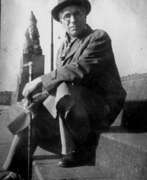

Rudolf Rudolfovich Frentz (Russian: Рудо́льф Рудо́льфович Фре́нц) was a Soviet and Russian painter, watercolorist, graphic artist, and art teacher, known for his contributions to the Leningrad School of Painting. Born on July 23, 1888, in Marienburg, a suburb of Saint Petersburg, he studied at the Imperial Academy of Arts under Vasily Savinsky and Nikolai Samokish. Frentz's early work focused on battle scenes, which became a hallmark of his style.
Frentz's work is celebrated for its dynamic composition and attention to historical detail, particularly in his depictions of military scenes. He was a member of the Leningrad Union of Artists and was deeply involved in the artistic community of Leningrad. His paintings, which often portrayed the heroism and struggles of Soviet soldiers, were exhibited in numerous prestigious shows and galleries throughout his career.
Notable works by Frentz include paintings like "Battle of Borodino" and "Storming of the Winter Palace," which are admired for their dramatic intensity and historical accuracy. His legacy continues to be honored in Russian art history, with his works held in collections such as the State Russian Museum and the Tretyakov Gallery.
Stay updated on new product sales and auction events related to Rudolf Rudolfovich Frentz by signing up for our updates. This subscription will only notify you of relevant sales and events.
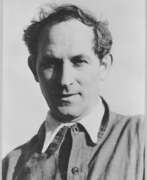

Naum Gabo, a pivotal figure in the evolution of twentieth-century sculpture, was a Russian-American artist renowned for his innovative approach to constructivism and kinetic art. Gabo's artistry transcended mere form to delve into the philosophical and spatial dynamics of sculpture, marking him as a pioneer in his field. He significantly influenced the avant-garde movements across Europe, particularly with his manifesto that challenged the concepts of Cubism and Futurism, advocating for art that embraced abstract reality and spiritual experience. His tenure at VKhUTEMAS, alongside notable contemporaries like Kandinsky and Rodchenko, was a testament to his influential role in post-Revolution Russian art.
Gabo's use of materials such as metal and glass was not just a stylistic choice but a profound exploration of volume and space without the reliance on mass, embodying the Constructivist ideology of functional art. His works, like "Column," showcased his interest in creating sculptures that resonated with intellectual and emotional appeal rather than just physical senses. This innovative approach to sculpture continued throughout his career, evident in his contributions to both the art and architectural domains, including his experimental architectural designs like the proposal for the Palace of the Soviets.
Throughout his life, Gabo's artistic journey was marked by a constant exploration of the interplay between space and time, evident in pieces such as "Spiral Theme" and his involvement in kinetic sculpture. His move across countries, from Russia to the United States, was reflective of his quest for new artistic contexts and his escape from political turmoil. Gabo's legacy is preserved in significant collections and museums worldwide, including the Museum of Modern Art (MoMA) in New York, where his works continue to inspire and captivate audiences.
For those intrigued by Naum Gabo's profound impact on modern sculpture and constructivism, signing up for updates can enrich your knowledge and keep you informed about upcoming sales and auction events featuring his work. This is an opportunity to explore the depths of Gabo's contributions to art and architecture, ensuring enthusiasts and collectors stay connected to his enduring legacy.
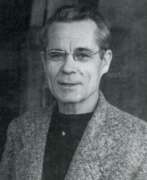

Taras Huriyovych Gaponenko (Russian: Тарас Гурьевич Гапоненко) was a prominent figure in Soviet art, distinguishing himself as both a passionate painter and a dedicated teacher. Born into a peasant family in 1906 in the Smolensk region, Gaponenko's early life was marked by hardship, including the loss of both parents at a young age. Despite these challenges, he demonstrated an unwavering commitment to his artistic education, which began in earnest when he enrolled at the VKhUTEMAS in Moscow in 1924. Under the tutelage of renowned artists such as Pavel Kuznetsov and Vladimir Favorsky, he honed his craft, eventually graduating in 1930 with the title of artist-painter.
Gaponenko's work vividly captures the spirit of the Soviet era, focusing particularly on themes of collective farm life, the Great Patriotic War, and the beauty of the Soviet landscape. His paintings, characterized by their deep emotional resonance and intricate depiction of Soviet life, earned him widespread acclaim. Notable works such as "At Dinner with Mothers" and "After the expulsion of the fascist invaders" received significant recognition, including a large gold medal at the World Exhibition in Paris and the USSR State Prize, respectively. His contributions to Soviet art are preserved in major collections, including the Tretyakov Gallery and the Russian Museum.
Beyond his achievements in painting, Gaponenko was deeply involved in the artistic community, contributing as a member of prestigious art associations and serving in significant roles within the Union of Artists of the USSR. His journey from a challenging childhood to becoming a People's Artist of the USSR is a testament to his resilience, talent, and the profound impact of his work on Soviet art.
For those passionate about the history of Soviet art and the legacy of its artists, Taras Huriyovych Gaponenko's story is both inspiring and enlightening. His life and work offer a window into the soul of an era, capturing the essence of its people and their struggles with remarkable depth and sensitivity. To stay updated on exhibitions and sales related to Gaponenko's art, sign up for updates and immerse yourself in the rich tapestry of Soviet cultural heritage.


Alexander Fedorovich Gaush (Russian: Александр Фёдорович Гауш), born in 1873 and passing away in 1947, was a distinguished Russian painter whose contributions to art spanned various genres and styles, with a particular emphasis on landscape and still life paintings. His education under the tutelage of prominent artists like P. P. Chistyakov and at the St. Petersburg Academy of Arts, as well as his time at the Académie Julian in Paris, played a significant role in shaping his artistic direction. Gaush's involvement with the "New Society of Artists" and the "World of Art" association highlighted his active engagement with the artistic movements of his time.
Gaush's teaching career in institutions across Petrograd, Sevastopol, and Odessa further underscores his dedication to nurturing the next generation of artists. His works, celebrated for their vivid portrayal of the Russian and Crimean landscapes, are housed in art galleries and museums across Russia, Ukraine, and other countries, testament to his lasting influence and the appreciation of his talent on a global scale.
Collectors and art experts continue to value Gaush's artworks for their historical significance and the unique perspective they offer on the landscapes he depicted. His works, often featured in auctions, reflect not only his skill and versatility but also the rich cultural and artistic heritage of his time.
For enthusiasts keen on exploring Gaush's legacy or adding his works to their collections, staying informed about new sales and auction events is crucial. Signing up for updates related to Alexander Fedorovich Gaush can ensure you don't miss out on the opportunity to own a piece of this illustrious artist's legacy.
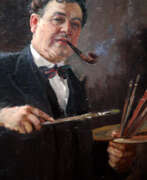

Aleksandr Mikhailovich Gerasimov (Russian: Алекса́ндр Миха́йлович Гера́симов) was a Russian and Soviet painter, born on August 12, 1881, in Kozlov (now Michurinsk), in the Tambov Governorate of the Russian Empire. He is best recognized for his leading role in promoting socialist realism in visual arts, notably through his portraits of Joseph Stalin and other Soviet leaders. Gerasimov's education at the Moscow School of Painting, Sculpture, and Architecture honed his skills, guided by masters like K.A. Korovin, A.E. Arkhipov, and V.A. Serov. His style, a blend of academic realism with impressionistic influences, vividly depicted the Russian landscape, leaders, and the daily life of the Soviet era.
His works, rich in emotionality and composition mastery, span across various themes from state portraits to landscapes and still lifes, showcasing a deep love for the Russian landscape's innate beauty. Gerasimov's contributions to art include not only significant political portraits but also captivating scenes of nature and life in Russia, marked by their emotional depth and vibrant colors. His paintings like "Stalin and Voroshilov in the Kremlin" won him the Stalin Prize in 1941, cementing his status in Soviet art history.
Gerasimov's artistry extends beyond his political work; his landscapes and portrayals of Russian expanses convey a deep lyrical sentiment, reflecting his profound connection and love for his homeland. His mastery across various mediums—oil, watercolor, gouache, and more—allowed him to explore and express a wide range of subjects, from portraits and landscapes to still lifes, showcasing his versatility and depth as an artist.
For those interested in the intersection of art and history, Aleksandr Mikhailovich Gerasimov's work offers a fascinating window into Soviet-era Russia, its leaders, and its landscapes. To stay updated on exhibitions and sales of Gerasimov's works, sign up for updates specifically focused on new product sales and auction events related to this distinguished artist.
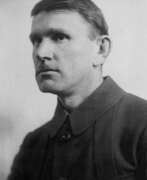

Sergey Vasilyevich Gerasimov (Russian: Серге́й Васи́льевич Гера́симов) is a celebrated figure in the annals of Russian art, known for his adept navigation through various artistic movements, transitioning from Impressionism to the robust narratives of Socialist Realism. Born in Mozhaisk, Russia, in 1885, his multifaceted career spanned painting, teaching, and book illustration, marking him as a versatile artist and educator. Educated under prominent figures such as Konstantin Korovin, Gerasimov dedicated a significant part of his life to nurturing the next generation of artists.
His artistic oeuvre is notable for its versatility and emotional depth, capturing the Soviet ethos with a unique blend of realism and evocative landscape and genre paintings. His work during critical periods in Soviet history, including the Stalin era and World War II, offers a vivid portrayal of the times. Gerasimov's mastery is evident in celebrated pieces like "The Peasant Uprising of 1860" and "Collective Farm Holiday," which are held in high esteem and displayed in prestigious venues such as the Tretyakov Gallery.
Gerasimov's legacy extends beyond his paintings. As an influential teacher at the Surikov Art Institute, he shaped the careers of numerous Soviet artists, leaving a lasting impact on the artistic landscape. His dedication to art and education has cemented his status as a revered figure in the history of Russian and Soviet art.
For those interested in the rich heritage of Russian art, Sergey Vasilyevich Gerasimov's life and work present an invaluable perspective on the cultural and political shifts of his era. His legacy continues to inspire and influence, making his art a focal point for collectors and art aficionados alike.
To stay abreast of the latest findings and exhibitions featuring Gerasimov's compelling works, signing up for updates is highly recommended. This subscription will ensure that enthusiasts are well-informed about upcoming sales and auction events showcasing the timeless creations of Sergey Vasilyevich Gerasimov.
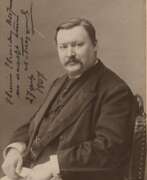

Aleksandr Konstantinovich Glazunov (russian: Александр Константинович Глазунов) was a Russian late Romantic composer, conductor and teacher.
Glazunov belonged to a well-known dynasty of book publishers in St. Petersburg and showed musical ability early on. He studied music with Balakirev and Rimsky-Korsakov, wrote his first symphony at the age of sixteen, and was noticed by the patron of the arts Mitrofan Belyaev, who became his admirer and benefactor. Thanks to him, the young Glazunov traveled all over Europe and was introduced in Weimar to Franz Liszt, who promoted the performance of his First Symphony at the congress of the General German Musical Union.
After the death of composer Borodin, Glazunov helped Rimsky-Korsakov finish his opera Prince Igor, and in the late 1890s he was already collaborating with the Imperial Theaters and writing three ballets. In 1899 Glazunov was appointed professor at the St. Petersburg Conservatory, and from the end of 1905 he became its director, retaining this post even after the October Revolution of 1917. Glazunov's personality is characterized by the fact that he spent his director's salary on helping poor students. And in general, during the hungry years of post-revolutionary devastation, he supported students, even if he did not share their musical beliefs - among them the greats Sergei Prokofiev and Dmitri Shostakovich.
In 1922, Aleksandr Glazunov was named People's Artist of the young Soviet republic. In 1928 he traveled to Vienna to take part in the jury of the Schubert Centenary Composition Competition and never returned to the USSR. However, even while living in Europe, he retained his Soviet citizenship. Officially, Glazunov's stay in Paris was explained by his serious state of health and the need for medical treatment. Already in 1972 Glazunov's ashes were transported to the USSR and reburied in the Alexander Nevsky Lavra.
In addition to ballets, Aleksandr Glazunov wrote eight symphonies (the ninth remained unfinished), seven string quartets and a great deal of orchestral music. He wrote mainly for piano and organ, and at the end of his life he composed works for saxophone - a solo concerto and a quartet for saxophones. Glazunov's most popular works today are his ballets The Seasons (1898) and Raymonda (1897), his Fourth, Fifth and Sixth Symphonies, the Polonaise from Les Sylphides, and his two concert waltzes.
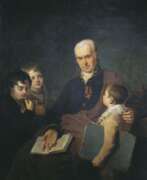

Kirill Ivanovich Golovachevsky (Russian: Кирилл Иванович Головачевский) was a Russian artist and graphic designer, best known for his role as an inspector at the Imperial Academy of Arts in St. Petersburg from 1771-1773 and 1783-1823. Born on May 27, 1735, in Korop, Russian Empire, he initially joined the Kiev Theological Academy but was later sent to St. Petersburg as a court chorister. Under the patronage of Empress Catherine II, Golovachevsky studied painting with Ivan Petrovich Argunov alongside his fellow choristers.
Though not considered a leading artist of his time, Golovachevsky contributed significantly to the Russian art scene through his portraits and historical paintings. His career at the Academy spanned over four decades, where he played a pivotal role in developing the institution's educational programs and nurturing the next generation of Russian artists.
Golovachevsky's works, such as the portrait of Elizabeth Sofie Albertine von Graevenitz, have been recognized in the art market, reflecting his skill in portrait art despite the criticisms of his contemporaries regarding his artistic abilities.
For collectors and art experts interested in Russian art and antiques, staying informed about updates and auction events related to Kirill Ivanovich Golovachevsky can provide valuable insights into this historical artist's contributions. Sign up for updates to ensure you don't miss out on new discoveries and sales related to his works.
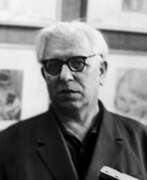

Vladimir Alexandrovich Gorb (Russian: Влади́мир Алекса́ндрович Го́рб) was a Soviet Russian artist, renowned for his versatile talents in painting, graphic design, and art education. Born on December 31, 1903, in Odessa, Russian Empire, Gorb carved a niche for himself in the Leningrad art scene, contributing extensively to its richness and diversity.
Gorb's education at the Leningrad VKHUTEIN under influential teachers like Alexander Savinov and Kuzma Petrov-Vodkin equipped him with a formidable artistic foundation, which he expanded upon throughout his career. His works, characterized by their vivid portrayal of everyday life and the natural world, were regularly featured in prominent exhibitions from as early as 1925.
Over the years, Gorb became a significant figure in the Soviet art community, not only through his artwork but also through his role as a professor at the Repin Institute of Arts. His commitment to art education shaped many future artists. His works are notable for their depth and complexity, encapsulating the Soviet ethos with a unique blend of realism and personal expression.
For those interested in exploring the works of Vladimir Gorb further or acquiring pieces for their collections, more information is available through dedicated art galleries and historical art resources online. For updates on exhibitions and available works of Vladimir Gorb, you can subscribe to our newsletter, ensuring you're informed about new sales and auction events related to this distinguished artist.


Gavriil Nikitich Gorelov (Russian: Гавриил Никитич Горелов) was a Russian and Soviet artist of the first half of the twentieth century. He is known as a painter, graphic artist and teacher.
Gavriil Gorelov studied at the St. Petersburg Academy of Arts under Ilya Repin and Franz Roubaud. He created historical canvases, genre paintings and portraits. During a study trip to Italy, he painted "Orgy in the apartments of Alexander VI Borgia". Returning to Russia, the artist became a member of the Association of Traveling Art Exhibitions. Among his famous works are "Pugachev's Trial of a Landowner", "Pugachev's Execution", "Bolotnikov's Revolt", "Minin's First Appeal to the People", "Dogs-Knights". He also participated in the creation of the panorama "The Storming of Perekop".
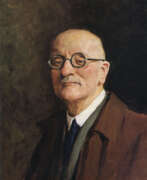

Igor Emmanuilovich Grabar (Russian: И́горь Эммануи́лович Граба́рь) was a distinguished Russian painter, art historian, and museum administrator, whose contributions have left an indelible mark on the world of art. Renowned for his versatility, Grabar was not only a masterful artist but also a visionary in art preservation and education. His work reflects a deep appreciation for Russia's cultural heritage, capturing the essence of its landscapes, historical moments, and architectural beauty with a unique blend of realism and impressionism.
Grabar's significance extends beyond his paintings; he played a pivotal role in the preservation of Russian art, overseeing restoration projects and establishing guidelines that are still in use today. His efforts in cataloging and promoting Russian art helped to elevate the profile of Russian culture on the global stage. Among his well-known works, "February Azure" stands out for its captivating use of color and light, showcasing Grabar's skill in conveying the beauty of Russian winters.
As an educator and museum director, Grabar influenced generations of artists and art historians, embedding a deep respect for artistic heritage and innovation. His leadership at the Tretyakov Gallery and involvement in various art schools helped to shape the direction of Russian art in the 20th century. Grabar's legacy is not just in his artworks but also in his contributions to art education and museum practices, making him a revered figure among collectors, experts, and enthusiasts of art and antiques.
For those passionate about the rich tapestry of Russian art and culture, Igor Emmanuilovich Grabar's work remains a source of inspiration and admiration. We invite collectors and art experts to sign up for updates on new product sales and auction events related to Grabar's work. This subscription is your gateway to the world of a visionary artist whose influence continues to resonate in the art world.
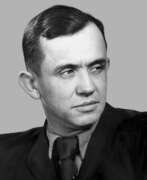

Sergey Alekseyevich Grigoryev (Russian: Сергей Алексеевич Григорьев) was a distinguished Soviet and Ukrainian artist, born in 1910 in Lugansk, Ukraine. With a rich educational background from the Zaporozhe Arts and Crafts School, Moscow VKHUTEMAS, to the Kiev Art Institute, Grigoryev's journey in the arts began early and was marked by significant achievements and contributions. He became a beacon of Socialist Realism, earning accolades such as the Stalin Prizes in 1950 and 1951, and the prestigious title of People's Artist of the USSR in 1974.
Grigoryev's work spans a variety of genres, including genre art, portraiture, and educational pieces that delve into themes of family, Soviet life, and the nurturing of young minds. His art is celebrated for its attention to detail, the vibrancy of national characteristics, and an unwavering commitment to depicting the truthfulness of life. Among his notable works are "Admission into the Komsomol" and "The Goalkeeper," housed in the Tretyakov Gallery, which exemplify his masterful portrayal of everyday life and the human condition.
His paintings, like "Nuvole estive" and "Bambina che disegna," have found places in esteemed auctions, reflecting the enduring value and appeal of his work to collectors and art enthusiasts. As an educator and a member of the USSR Academy of Arts, Grigoryev's legacy extends beyond his canvas, influencing generations of artists and shaping the landscape of Soviet and Ukrainian art.
For collectors and experts in art and antiques, the work of Sergey Alekseyevich Grigoryev offers a window into the soul of a period rich with history and transformation. His oeuvre represents not only the pinnacle of artistic achievement under the banner of Socialist Realism but also a deeply personal exploration of the human experience. To stay updated on sales and auction events featuring Grigoryev's work, signing up for updates is a step towards owning a piece of this historic tapestry.
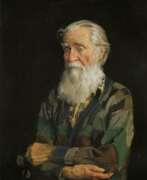

Aleksei Mikhailovich Gritsai (Russian: Алексей Михайлович Грицай) was a Soviet and Russian artist, celebrated for his profound landscape paintings that evoked a deep appreciation for nature's power to inspire humanity. Born on March 7, 1914, in St. Petersburg, Russia, Gritsai's early education in art took place in Leningrad under the guidance of notable figures such as S.M. Zaidenberg, P.S. Naumov, Vasily Yakovlev, and Isaak Brodsky. His unique approach to landscape art, marked by richly colored seasonal rural scenes featuring rolling hills, rivers, and trees, garnered significant acclaim. Beyond his artistic achievements, Gritsai was also recognized as an influential educator, teaching at the Art School in memory of 1905 and the Moscow State Art Institute named after Surikov, where he emphasized the importance of drawing, perspective, and composition in expressing talent.
Throughout his career, Gritsai was honored with prestigious titles and awards, including being named a People's Artist of the USSR in 1974, an academician of the USSR Academy of Arts in 1964, and the recipient of two Stalin Prizes (1951 and 1952) as well as a USSR State Prize in 1978. His dedication not only revived the Russian landscape genre in post-war Soviet art but also made a significant contribution to educating the next generation of artists.
Gritsai's works are part of the collections of major Russian museums, such as the State Tretyakov Gallery in Moscow and the State Russian Museum in St. Petersburg, showcasing his enduring legacy in the canon of Russian art.
For collectors and experts in art and antiques, Gritsai's work remains a testament to the beauty and depth of the Russian landscape, reflecting a deep bond with nature and a nuanced understanding of its essence. His paintings are not only visually stunning but are imbued with the emotional depth and the poignancy of reminiscence, particularly in his later years when he relied on memory due to reduced mobility.
If you're interested in updates related to Aleksei Mikhailovich Gritsai, including new product sales and auction events, sign up for our newsletter. This subscription is specifically tailored for collectors and art enthusiasts eager to stay informed about opportunities to acquire pieces by this remarkable artist.
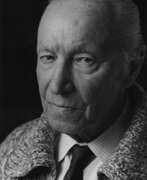

Antanas Gudaitis (Russian: Антанас Мартино Гудайтис), a Lithuanian painter born on July 29, 1904, in Šiauliai, and passing away on April 20, 1989, in Vilnius, was a pivotal figure in Lithuanian art, particularly noted for his contributions to modern expressionist and colorist painting. His studies spanned from the teacher's seminar in Šiauliai to literature at the University of Lithuania, and art at the Kaunas School of Art. Gudaitis further honed his skills in Paris at the National School of Decorative Arts and various private studios until 1933. His career as an educator included positions at the Vilnius Art School, Vilnius Art Academy, and the Vilnius Art Institute, where he was bestowed the title of professor in 1947. Gudaitis's recognition in the Lithuanian art scene was marked by honors such as the title of Meritorious Artist of the LSSR in 1961 and the laureate of the LSSR State Prize in 1965.
His body of work spans portraits, still lifes, and landscapes, showcasing a distinctive style that evolved from decorative and semi-abstract forms to more relief-rich and vibrant color palettes. Gudaitis's art reflects a deep engagement with Lithuanian moods and themes, often weaving intricate metaphors about contemporary life and human relationships. He was instrumental in the establishment of the Lithuanian modernist artist group "Ars" and remained an active member of the Lithuanian Artists' Union from 1935. His impact extended beyond his art, as he nurtured and influenced generations of students, imbuing them with a sense of creativity and resilience.
Antanas Gudaitis is celebrated for bringing avant-garde elements into the Lithuanian art scene and is recognized for his lyrical expressionism. His legacy is underscored by his ability to embody and impart the fundamental tenets of twentieth-century art—freedom, modernity, and national identity—despite the challenging socio-political landscapes of his time. Gudaitis's influence was profound, not just in his artworks, but in his dynamic role as a cultural figure, educator, and free spirit who endured dramatic circumstances without succumbing to them.
For art collectors and experts, Gudaitis's works offer a profound connection to the evolution of Lithuanian modern art, presenting opportunities to explore the rich textures, colors, and symbolic content that define his oeuvre. To stay updated on new product sales and auction events related to Antanas Gudaitis, signing up for updates is highly recommended, promising a gateway to the rich legacy and continued appreciation of his contributions to the art world.


Lado Gudiashvili (Russian: Ладо Давидович Гудиашвили) was a Georgian artist, celebrated for his distinctive and innovative contributions to 20th-century art. Born in Tbilisi, Gudiashvili embarked on his artistic journey at the Tbilisi school of sculpture and fine art, later enhancing his skills in Paris's Ronson's private academy. His work, deeply influenced by Georgian life and culture, masterfully blends dramatic grotesque with poetic mystery, often incorporating elements of Caucasian and Persian traditions.
Gudiashvili's artistic repertoire was vast, encompassing painting, book design, graphic art, and teaching. He was an integral part of the Tbilisi Modernism and Socialist Realism periods, contributing significantly over a 60-year career. His engagement with avant-garde circles in Tbilisi and his murals for popular cafes showcased his versatility and creativity. Gudiashvili's Paris years (1919-1926) were marked by independence and recognition, as he exhibited alongside notable contemporaries and was encouraged to showcase his work independently.
His contributions were not limited to canvas; Gudiashvili also left an indelible mark on set design and book illustration, working on productions and literary classics that remain influential. Notably, his works adorn the Kashveti Church in Tbilisi, a testament to his monumental talent. Despite facing challenges, including political pushback for his church paintings, Gudiashvili's legacy as a pioneering Georgian artist remains undisputed. He received several high Soviet honors, underscoring his significance in the art world.
For collectors and experts in art and antiques, Gudiashvili represents a vital link between Georgian cultural heritage and modernist expressions. His works, which include engaging illustrations, set designs, and captivating paintings, continue to attract interest for their historical significance and artistic value.
To stay updated on sales and auction events featuring Gudiashvili's works, sign up for updates. This subscription will ensure you're informed about opportunities to acquire pieces by this remarkable Georgian artist.
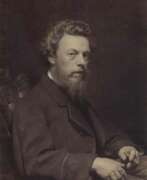

Apolinary Gilyaryevich Horawski (Russian: Аполлинарий Гиляриевич Горавский) was a Belarusian-born Polish painter, acclaimed for his significant contributions to 19th-century European art, particularly during his time in St. Petersburg. Born on January 23, 1833, Horawski's artistic journey began in his youth, showing a keen interest in drawing and painting over military disciplines while at the Brest-Litovsk Cadet Corps. This passion led him to the Imperial Academy of Arts, where he studied under notable instructors and eventually graduated with a gold medal.
Horawski is celebrated for his masterful landscapes and portraiture, which vividly captured the essence of Eastern European rural life. His works often depict serene natural settings and the daily lives of the local people, earning him a place in prestigious collections, including the Belarusian National Arts Museum and the State Tretyakov Gallery. Some of his notable works include "Evening in Minsk" and "Portrait of a Young Woman in a White Dress."
The artist's legacy continues to influence art collections and is frequently featured at international auctions, where his pieces are highly valued for their historical and artistic significance. Collectors and art enthusiasts interested in Horawski's work can explore his paintings and their impact on 19th-century art at major auctions and exhibitions globally.
For enthusiasts of 19th-century European art and collectors eager to discover more about Apolinary Horawski's work, subscribing to our newsletter is an excellent way to stay informed about upcoming sales and auction events featuring his art. Ensure you don't miss out on acquiring a piece of this celebrated artist's legacy. Sign up today to receive exclusive updates and insights!
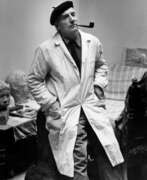

Stanisław Horno-Poplawski was a Polish sculptor, artist and teacher.
In the late 1910s, young Stanisław became interested in painting and art in Moscow, where his family moved from Georgia, then continued his studies at the Warsaw School of Fine Arts. Stanisław Gorno-Poplawski made the subject of his sculpture a rough field stone, giving it the features of famous and unknown Poles' faces, creating compositions filled with life. His works can be seen in many museums in Poland and the world.
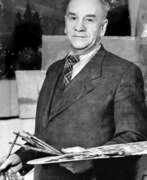

Boris Vladimirovich Ioganson (Russian: Борис Владимирович Иогансон) was a distinguished Russian and Soviet painter, whose life spanned from 1893 to 1973. Born in Moscow, his early artistic journey was shaped by the cultural vibrancy and educational opportunities of the city. He honed his craft at the Moscow School of Art under the tutelage of prominent artists like Kelin, Kasatkin, and Malyutin, eventually emerging as a forceful advocate for Constructivism before shifting his focus to easel painting and becoming a leading figure in the Socialist Realism movement. His work, notably inspired by Repin, carries undertones of Impressionism while narratively depicting the complexities of Soviet life.
Ioganson's contributions extended beyond his creations; he played a pivotal role in nurturing future talents. From 1930 to the 1950s, he led a workshop at the St. Petersburg Institute for Painting, Sculpture and Architecture, influencing a generation of artists. His notable students included Alexey Eriomin, Nikolai Baskakov, and Valery Vatenin, among others, who carried forward his artistic legacy.
Throughout his career, Ioganson engaged deeply with the themes of Soviet existence, weaving narratives that captured the ethos of the era. His works, such as "Interrogation of the Communists" and "At the Old Ural Plant," reflect a nuanced exploration of Soviet societal dynamics, heroism, and the psychological landscapes of its people. These pieces, characterized by their storytelling depth and emotive power, have earned Ioganson a revered place in art history.
For collectors and experts in art and antiques, Ioganson's oeuvre presents a compelling exploration of Soviet-era narratives through the lens of Socialist Realism. To stay updated on new discoveries, sales, and auction events related to Boris Vladimirovich Ioganson's work, signing up for updates is highly recommended. This ensures that enthusiasts and collectors are always informed about the latest developments and opportunities to engage with Ioganson's impactful artistic legacy.
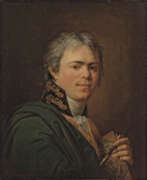

Andrey Ivanovich Ivanov (Russian: Андрей Иванович Иванов) was a distinguished Russian painter, renowned for his contributions to Neo-Classical art, particularly in historical scenes. Born in Moscow in 1775 and passing away in Saint Petersburg in 1848, Ivanov's journey in art was marked by his deep involvement with the Imperial Academy of Arts. From a young age, he demonstrated exceptional talent, receiving numerous accolades, including the prestigious Big Gold Medal from the Academy in 1797.
Ivanov's oeuvre is a testament to his mastery of historical and biblical narratives, capturing the essence of classical storytelling through his brush. Notable works such as "Prince Mstislav defeating Rededya" and "The Young Hero from Kiev" are just glimpses into his profound artistic legacy. His paintings not only reflect his technical skill but also his deep engagement with Russian history and mythology, contributing significantly to the cultural tapestry of his time.
Tragically, Ivanov's career faced challenges, particularly following his controversial painting "The Death of General Kulnev," which led to his removal from the Academy. Despite this setback, he continued to influence the art world, leaving a lasting legacy that includes his role as a teacher to prominent artists like Karl Briullov and his own son, Alexander Andreyevich Ivanov.
For art collectors and enthusiasts, Ivanov's work offers a rich exploration of Russian classicism, imbued with historical depth and artistic excellence. His paintings, preserved in museums and galleries, continue to inspire and captivate audiences, underscoring his enduring impact on the world of art.
For those keen on delving deeper into Ivanov's artistic journey and viewing his works, consider signing up for updates. This subscription will keep you informed about new product sales and auction events related to Andrey Ivanovich Ivanov, ensuring you stay connected to the legacy of this remarkable artist.
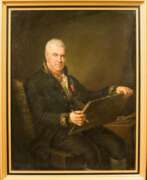

Mikhail Matveevich Ivanov (Russian: Михаил Матвеевич Иванов) was a Russian painter and watercolorist, born in 1748 in St. Petersburg. He is recognized for his landscape and battle scene paintings. Ivanov's early training was at the Imperial Academy of Arts, where he studied under Ivan Groot and later, Jean-Baptiste Le Prince in Paris. His works often depicted detailed landscapes and significant historical events.
Ivanov earned acclaim for his watercolors and drawings, many of which are housed in the State Russian Museum and the Hermitage Museum. Notable works include "View of Three Churches Against the Backdrop of Mount Ararat" and "Russian Fleet in the Bosphorus Strait".
Collectors and art enthusiasts highly regard Ivanov's contribution to Russian art, particularly his ability to capture the essence of the landscapes and historical moments of his time. To stay updated on new works and auction events related to Mikhail Matveevich Ivanov, sign up for our updates.
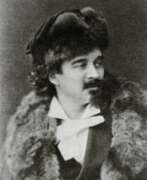

Valery Ivanovich Jacobi (Russian: Валерий Иванович Якоби), a distinguished Russian painter, is celebrated for his significant contributions to the art world, particularly in the realms of culture, painting, and sculpture. Born in the mid-19th century, Jacobi's artworks encapsulate the essence of Russian life, history, and landscapes, showcasing his profound understanding and appreciation of his homeland's spirit.
Jacobi's talent was not confined to a single genre; instead, he excelled in portraying historical scenes, everyday life, and landscapes with equal finesse. His paintings are renowned for their vivid storytelling, attention to detail, and the ability to evoke emotion. Jacobi's work offers a window into the Russian soul, reflecting the nation's culture and traditions through the lens of art. His mastery over color and form allowed him to create pieces that are not only visually stunning but also rich in narrative and depth.
Several of Jacobi's masterpieces have found homes in prestigious museums and galleries, marking him as a pivotal figure in Russian art history. His contributions have left an indelible mark on the art world, influencing generations of artists and art aficionados alike. For collectors and experts in art and antiques, Jacobi's works represent a valuable intersection of historical significance and aesthetic beauty, making them highly sought after in the art market.
For those intrigued by the legacy of Valery Ivanovich Jacobi and wish to delve deeper into the world of Russian art and culture, signing up for updates can be a rewarding endeavor. Subscribing will not only keep you informed about new product sales and auction events related to Jacobi's work but also offer insights into the broader realm of art and antiques. This opportunity allows enthusiasts to stay connected with the vibrant history and ongoing appreciation of Jacobi's contributions to the art world.
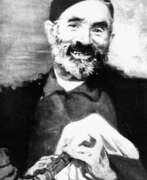

Ucha Malakievich Japaridze (Russian: Уча Малакиевич Джапаридзе) was a prominent Soviet and Georgian painter, born on August 17, 1906, in the village of Gari, Georgia. His life and work significantly contributed to the development of 20th-century Georgian visual arts, making him a key figure in this field. Japaridze's artistic journey was marked by his dedication to capturing the essence of Georgian heritage and the people's historical past through his paintings, including detailed portraits, monumental wall paintings, and book illustrations.
Throughout his career, Japaridze was recognized with numerous awards, reflecting his importance and contribution to the arts in Georgia. He held prestigious titles such as Public Artist of the Georgian SSR and Honored Artist of Georgia. His role as an academician at the Georgian Academy of Arts and his tenure as chancellor at the Tbilisi State Academy of Arts were testament to his influence and leadership in the artistic community.
Japaridze's works are celebrated for their variety and technical mastery, covering diverse fields and themes that resonated with the significant events of his time. His legacy continues to be preserved in several museums and private collections both in Georgia and internationally, including the Georgian National Museum of Fine Arts and the National Gallery of Georgia. Notably, his former home in Tbilisi has been transformed into a museum, housing his paintings, graphics, and documentary materials, offering insight into his life and artistic achievements.
For collectors and art experts interested in Soviet and Georgian visual arts, Japaridze's oeuvre represents a critical link to the cultural and historical narrative of Georgia. His ability to intertwine the personal with the collective experience of his homeland offers a profound perspective on the artistic movements of his time.
To stay informed on updates and opportunities related to Ucha Malakievich Japaridze's works, including sales and auction events, sign up for updates. This subscription ensures you're always in the loop regarding new discoveries and collections featuring Japaridze's art.
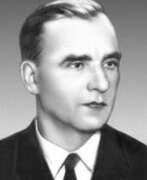

Vytautas Jurkūnas (Russian: Витаутас Юркунас) was a Lithuanian graphic artist, celebrated for his distinctive approach to printmaking and book illustration. Born in 1910 in Vindeikiai, he carved out a significant presence in the Lithuanian art scene from the interwar period through to the late 20th century, until his death in 1993 in Vilnius. Jurkūnas' education at the Kaunas School of Art laid the groundwork for a career that spanned teaching at the Vilnius Art Institute, where he influenced generations of artists, and exploring a wide array of graphic techniques, notably in linocut and wood engraving.
His early works, such as "Mother with Child" (1935) and the "Fishermen" series (1937-1939), showcase a unique style characterized by expressive lines, dynamic strokes, and a blend of realism with abstraction. During WWII, Jurkūnas produced compelling compositions reflecting the brutality of war, which added depth to his portfolio of socially and politically charged themes. Post-war, he gained renown for his book illustrations, employing linocut and wood engraving techniques to create images that resonated deeply with the textual narratives they accompanied. Notably, his illustrations for Kristijonas Donelaitis' "The Seasons" received significant acclaim.
Jurkūnas' contributions to Lithuanian graphic art are preserved in the collections of the National M. K. Čiurlionis Art Museum, the Lithuanian National Museum, and internationally, showcasing his enduring legacy. His work received the LSSR State Prize in 1957, marking a high point in his career and affirming his status as a pivotal figure in Lithuanian art.
For collectors and experts in art and antiques, Vytautas Jurkūnas' oeuvre offers a compelling study in the evolution of Lithuanian graphic art, with works that reflect the socio-political landscape of his time and his mastery of graphic techniques. To stay updated on exhibitions and auctions featuring Vytautas Jurkūnas' works, sign up for updates. These subscriptions provide insights into new sales and events dedicated to his legacy, offering a unique opportunity to engage with the rich history of Lithuanian art.
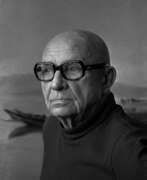

Eduards Kalniņš (Russian: Эдуард Фридрихович Калнынь), born on October 25, 1904, in Riga, Latvia, was a renowned Latvian painter and esteemed educator, notably remembered as the nation's most distinguished marine artist. His early artistic education was shaped under the tutelage of J. Moškevič in Tomsk during his family's refuge period, eventually culminating at the Art Academy of Latvia, where he honed his craft under Vilhelms Purvītis. Kalniņš's tenure at the Art Academy of Latvia as a professor from 1955, after serving as a docent from 1947, significantly influenced the post-war generation of Latvian painters, establishing him as a pivotal figure in Latvian art education.
His artistry was deeply interconnected with exploring the bonds between art and reality, dedicating a considerable part of his work to portraying the lives and environments of fishermen, which later became emblematic of the Latvian painting school. Kalniņš was celebrated for his emotional and profound engagement with reality, high painting culture, and spiritual vitality, often depicted through landscapes and still lifes.
Kalniņš's contributions were internationally acknowledged through exhibitions and awards. He was the first laureate of the prestigious Rome Prize in 1935, which facilitated his studies in Italy, profoundly influencing his artistic palette and style. His works were celebrated in personal exhibitions across Riga, Japan, and various European countries, consolidating his legacy within the global art community.
For art collectors and enthusiasts intrigued by Eduards Kalniņš's profound influence on Latvian maritime painting and his innovative contributions to art education, his works offer a deep dive into the soul of Latvian natural and cultural landscapes. His legacy, marked by vibrant portrayals and educational leadership, continues to inspire and resonate. To stay updated on sales and auction events related to Eduards Kalniņš's art, signing up for updates is highly recommended, ensuring enthusiasts are promptly informed about opportunities to engage with his timeless works.
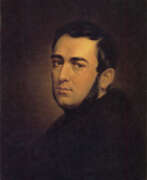

Jan Ksawery Kaniewski (Russian: Ян Ксаверий Каневский) was a Polish and Russian artist of the mid-19th century. He is known as a portrait painter.
Jan Kaniewski painted numerous portraits of members of the Russian imperial family (including Nicholas I) and the high society of the Kingdom of Poland. He also created a number of paintings on historical and religious themes.
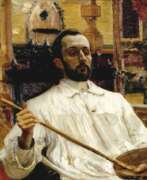

Dmitry Nicolajevich Kardovsky (Russian: Дмитрий Николаевич Кардовский) was a Russian artist, illustrator, and stage designer, celebrated for his multifaceted contributions to the world of art. Born in 1866 near Pereslavl-Zalessky, Kardovsky initially pursued law at Moscow University before devoting himself to art at the Imperial Academy of Arts under the tutelage of Pavel Chistyakov and Ilya Repin. His educational journey included a period in Munich, studying with Anton Ažbe, which enriched his artistic approach, combining Russian and European influences.
Kardovsky is perhaps best known for his mastery in drawing and book illustration. His work, characterized by a deep understanding of the literature he illustrated, brought to life the narratives and characters of Russian literary classics by Chekhov, Gogol, Lermontov, and Tolstoy, among others. His illustrations for works such as "Kashtanka" by Anton Chekhov and "Nevsky Prospekt" by Gogol are particularly noted for their vivid expression and delicate precision.
Beyond his illustrative prowess, Kardovsky made significant contributions as an educator, imparting his knowledge to a generation of artists who went on to have distinguished careers of their own. His commitment to teaching was exemplified by an exhibition in 1929, where the majority of the works displayed were by his students, underscoring his influence and legacy in Russian art education.
Kardovsky's work extended to the theater, where he created costumes and scenery, notably for the Maly Theatre in productions of Ostrovsky and Turgenev. His engagement with historical themes was also prominent, with series of paintings reflecting key periods in Russian history, demonstrating his versatility and deep connection to his cultural heritage.
His latter years were spent in Pereslavl-Zalessky, where he continued to produce landscapes and portraits, capturing the essence of Central Russia and its inhabitants with a particular fondness and respect. Kardovsky's work remains an integral part of Russian and Soviet art history, bridging the styles of the Silver Age with post-revolutionary traditionalism.
For those interested in exploring the rich tapestry of Russian art and the pivotal role played by Dmitry Kardovsky, signing up for updates on new product sales and auction events related to his work is highly recommended. This subscription ensures enthusiasts and collectors alike stay informed about opportunities to engage with Kardovsky's enduring legacy.
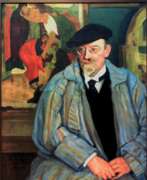

Ivan Semyonovich Kazakov (Russian: Иван Семёнович Казаков) was a Russian painter and graphic artist, known for his contributions to Orientalist art. Born on February 1, 1873, in Kasilova, Oryol Governorate, Kazakov studied at the Moscow School of Painting, Sculpture, and Architecture, and later at the Imperial Academy of Arts under the mentorship of Vladimir Makovsky.
Kazakov's work is notable for its vibrant depictions of Central Asian architecture and landscapes, particularly those of Samarkand, Bukhara, and Tashkent. His paintings often feature detailed portrayals of domes, minarets, and intricate patterns, capturing the essence of these historic cities. This unique focus on Orientalist themes distinguished him from his contemporaries and earned him a prominent place in Russian art history.
Throughout his career, Kazakov exhibited his works in significant venues in Saint Petersburg and Moscow. He also played a crucial role in the art community of Tashkent, where he taught and established his own studio. Several of his works are preserved in museums, including the State Russian Museum and regional art collections, which continue to attract art enthusiasts and collectors.
For updates on new works and auction events related to Ivan Semyonovich Kazakov, sign up for our exclusive alerts. Stay informed about the latest opportunities to acquire pieces by this remarkable artist.
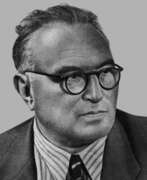

Yevgeny Adolfovich Kibrik (Russian: Евгений Адольфович Кибрик) was a prominent Soviet artist and illustrator, whose career spanned from the early 20th century until his death in 1978. Born into the turmoil of pre-revolutionary Russia, Kibrik developed a unique artistic voice that resonated with the cultural and political landscapes of his time. His early engagement with the analytical art movement, spearheaded by Pavel Filonov, significantly influenced his illustrative style. This can be seen in his illustrations for "Lieutenant Kizhe" by Tynyanov, where he first began to make a name for himself.
Kibrik's work is notable for its dynamic and expressive approach, often characterized by bold gestures and a vibrant use of color and form. This approach became particularly evident in his later works, such as the illustrations for "Colas Breugnon" by Romain Rolland, where he depicted full-bodied, epic characters with open, theatrical gestures (Arthive). His contribution to Soviet art was not just limited to his creations but extended to his role as an educator, shaping the next generation of Soviet artists through his long tenure as a professor at the Moscow state art Institute.
Kibrik's artistic legacy is preserved in various museum collections, including the State Tretyakov Gallery, the State Russian Museum, and the Pushkin State Museum of Fine Arts. His hometown of Voznesensk further honors his contributions with the Art Museum named after E. A. Kibrik, showcasing his vast body of work and continuing influence on Russian art.
For those intrigued by the evolution of Soviet art and the role of literature in shaping visual culture, Kibrik's work offers a fascinating study. His ability to weave narrative, emotion, and political commentary into his illustrations marks him as a key figure in the exploration of Soviet aesthetic and ideological expressions.
To stay updated on exhibitions and sales related to Yevgeny Adolfovich Kibrik's work, consider signing up for updates. This subscription will keep you informed about new product sales and auction events directly connected to his artistic legacy.
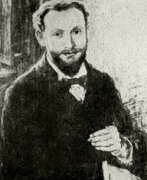

Solomon Yakovlevich Kishinevsky (Russian: Соломон Яковлевич Кишинёвский) was a Russian and Soviet artist of the late 19th and the first half of the 20th centuries of Jewish origin. He is known as a painter, graphic artist and teacher, a prominent representative of the Southern Russian school of painting.
Solomon Kishinevsky worked in domestic, portrait and landscape genres. At the beginning of his career, he was fond of German and Italian classicism, then French impressionism, but the first serious works he created under the strong influence of the Itinerants. His life sketches, scenes from the life of the urban poor were acutely social, the artist has a special attention to the everyday existence of the "little man.
Kishinevsky died presumably in 1941 during the Nazi occupation of Odessa.
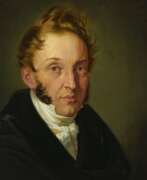

Aleksander Kokular was a Polish painter of the first half of the twentieth century. He is known as a painter and teacher, a representative of late classicism.
Aleksander Kokular was best known in the portrait genre. Models for his paintings were, in particular, the Russian Emperor Nicholas I, major Russian dignitaries, representatives of the Polish intelligentsia, the bourgeoisie and the clergy. The artist also painted pictures on historical, mythological and religious subjects.
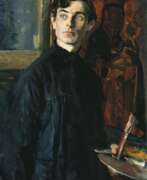

Pavel Dmitriyevich Korin (Russian: Павел Дмитриевич Корин) was a distinguished Russian painter and art restorer, celebrated for his contributions to Soviet art and his unfinished masterpiece, "Farewell to Rus." Born in 1892 in Palekh, a village renowned for its icon painters, Korin was destined for artistic greatness, following in the footsteps of his father, a professional icon painter. His education in iconography at Palekh and later training under prominent artists such as Mikhail Nesterov and Konstantin Korovin at the Moscow School of Painting, Sculpture, and Architecture shaped his artistic vision and technique.
Korin's career was marked by his exceptional ability to blend traditional Russian art forms with contemporary themes. His notable works include portraits of Soviet intelligentsia and frescoes that adorn the Moscow Metro stations and the Moscow Kremlin. Korin's dedication to his craft earned him numerous awards, including the Stalin Prize and the Lenin Prize, affirming his status as a master of Soviet art.
The artist's magnum opus, "Farewell to Rus," was inspired by the funeral of Patriarch Tikhon and aimed to depict the lost essence of Russia post-October Revolution. Despite four decades of preparatory work, including detailed studies and a life-sized copy of Alexander Ivanov's "The Appearance of Christ before the People," Korin never commenced the final painting. His painstaking preparation and dedication to this project, however, underscored his profound connection to Russian history and orthodoxy.
Korin's legacy extends beyond his paintings; he is remembered for his efforts to preserve Russian artistic and religious heritage, including saving the prized icons and frescoes of the Convent of Martha and Mary from destruction. His death in 1967 was mourned by both the clergy and laity, and his contributions continue to be celebrated in exhibitions and the collections he helped preserve.
For art collectors and experts, Korin's work represents a unique blend of traditional and modern, encapsulating the tumultuous history and cultural heritage of Russia. To stay updated on sales and auction events related to Pavel Dmitriyevich Korin, signing up for updates is highly recommended. This ensures exclusive access to valuable insights and opportunities to acquire works by one of Russia's most revered artists.
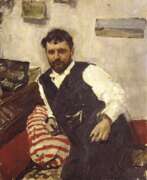

Konstantin Alekseyevich Korovin (Russian: Константи́н Алексе́евич Коро́вин) was a Russian artist and stage designer, renowned for his pivotal role in the transition from Russian Realism to Impressionism. Born in Moscow in 1861, Korovin's artistic journey began at the Moscow School of Painting, Sculpture, and Architecture, where he was heavily influenced by his mentor, Alexei Savrasov. His early work reflected the Realist tradition, but his style evolved after exposure to the vibrant art scenes of Paris and the influence of French Impressionists.
Korovin's contribution to art is marked by his vibrant palette and dynamic brushwork, capturing the transient effects of light and color with a spontaneity that was novel to Russian painting at the time. His works, ranging from lush landscapes and intimate still lifes to vivid portraits, showcase his mastery in evoking mood and atmosphere. Notably, his paintings of the Russian North and scenes of Parisian life have been celebrated for their lively, atmospheric qualities and are held in high esteem in museums and galleries worldwide, including the Tretyakov Gallery in Moscow and the Russian Museum in Saint Petersburg.
Beyond painting, Korovin's legacy includes significant contributions to theater design, where his innovative use of color and lighting brought new dimensions to stage productions in Russia, collaborating closely with the Moscow Art Theatre. His scenic designs for operas and ballets are credited with revolutionizing the visual aspect of Russian theater, making him a pivotal figure in both the visual and performing arts.
For collectors and experts in art and antiques, Korovin's works represent a unique blend of Russian tradition and Western artistic movements, making them highly sought after. His ability to capture the essence of a moment, whether in the tranquil Russian countryside or the bustling streets of Paris, continues to captivate audiences and scholars alike.
To stay informed on new sales and auction events featuring works by Konstantin Alekseyevich Korovin, sign up for our updates. This subscription ensures you're the first to know about valuable opportunities to add to your collection, focusing exclusively on Korovin's art and related events.
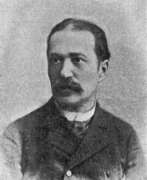

Pavel Osipovich Kovalevsky (Russian: Павел Осипович Ковалевский) was a Russian painter renowned for his battle scenes and genre paintings. Born in Kazan in 1843, Kovalevsky studied at the Imperial Academy of Arts in St. Petersburg under the mentorship of B.P. Villevalde. His early work earned him multiple accolades, including gold medals for significant paintings such as "Persecution of Turkish Foragers by Cossacks" and "First Day of the Battle of Leipzig in 1813".
Kovalevsky’s artistic journey took him across Europe as an academic scholar, visiting cities like Munich, Vienna, Rome, and Paris. His experiences and observations during these travels significantly influenced his work. During the Russo-Turkish War of 1877–1878, he served as a war artist attached to the Russian Army, documenting the campaign under Grand Duke Vladimir Alexandrovich. His notable works from this period include "The Staff of the 12th Battalion in Bulgaria" and "Captured Turks," which are housed in the State Russian Museum.
In addition to his battlefield illustrations, Kovalevsky contributed to the education of future artists by leading the workshop for military painting at the St. Petersburg Academy of Arts from 1897 until his death in 1903. His legacy includes numerous works depicting historical and military scenes, which continue to be celebrated for their detailed representation and historical accuracy.
For collectors and enthusiasts, keeping abreast of new acquisitions and auction events featuring works by Pavel Osipovich Kovalevsky is essential. Sign up for updates to stay informed about the latest sales and exhibitions related to his art.
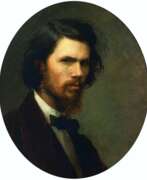

Ivan Nikolayevich Kramskoi (Russian: Иван Николаевич Крамской), a distinguished Russian painter and art critic, emerged as a pivotal figure in the Russian art scene during the latter half of the 19th century. Born into modest circumstances in 1837, Kramskoi's journey from a retoucher and watercolorist to a leading intellectual force in the art movement known as the Wanderers, or Peredvizhniki, underscores his dedication to art and its societal impact. His education at the St. Petersburg Academy of Arts was a turning point, leading to his active rebellion against academic art through the "Revolt of the Fourteen," which culminated in the formation of the Artel of Artists, a group advocating for realism and the moral duty of the artist.
Kramskoi's oeuvre is celebrated for its masterful portraits, which he paradoxically considered a burden yet excelled in, creating around 3,000 pieces that captured the essence of his subjects with unparalleled depth. His portraits of Russian writers, scientists, artists, and public figures are notable for their expressive simplicity and profound psychological insight, reflecting his democratic ideals and the belief in the artist's societal role. Among his well-known works are "Christ in the Desert" (1872), "Portrait of an Unknown Woman" (1883), and "Inconsolable Grief" (1884), all housed in the Tretyakov Gallery, showcasing his ability to blend portraiture with genre painting to explore complex emotions and moral-philosophical themes.
Despite his critical stance on portrait painting as mere means to support his family, Kramskoi's legacy is largely defined by these works, revealing the tensions between his artistic aspirations and the demands of livelihood. His leadership in the Association of Traveling Art Exhibitions (Peredvizhniki) significantly influenced Russian art, championing realism and accessibility of art to the public.
Kramskoi's personal life, marked by a marriage born out of a romantic and ideological alignment with the values of his time, and his untimely death at the age of 49 from an aortic aneurysm, add a poignant note to his story. His contributions to art and his critical perspectives on its role in society continue to be revered, making him an essential figure in the study of Russian realism and the broader art historical canon.
For collectors and experts in art and antiques, Kramskoi's works represent not only exceptional artistic achievements but also a window into the cultural and social dynamics of 19th-century Russia. His dedication to capturing the human spirit, whether in the guise of famous personalities or common folk, ensures his enduring relevance and appeal.
To stay updated on sales and auction events related to Ivan Nikolayevich Kramskoi's works, signing up for updates is a pragmatic step for enthusiasts keen on exploring the depths of Russian art and culture. This subscription is a gateway to engaging with the legacy of a painter who skillfully balanced personal conviction with public duty, leaving behind a rich trove of art that continues to inspire and captivate.
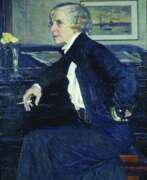

Elizaveta Sergeyevna Kruglikova (Russian: Елизавета Сергеевна Кругликова) was a Russian-Soviet artist, celebrated for her distinctive contributions to etching, silhouette art, and monotyping. Born into a St. Petersburg family with a deep appreciation for art, Kruglikova's talent blossomed early, supported by the artistic atmosphere at home. She honed her skills at the Moscow School of Painting, Sculpture and Architecture before moving to Paris, where she immersed herself in the city's vibrant art scene. From 1902, she experimented with etching, eventually becoming a notable figure in this field.
Kruglikova's Parisian period was marked by her work at the Académie de La Palette, where she both studied and taught, making significant contributions to the art of etching. Her return to Russia at the onset of World War I marked a new phase in her career, as she began exploring the realm of silhouette art, creating evocative portraits and scenes that captured the spirit of her subjects with striking clarity.
Perhaps most renowned for her pioneering work in monotype, a printing technique that allowed her unique expressivity, Kruglikova's art straddles the line between printmaking and painting. Her creations, ranging from the depiction of Parisian life to the vibrancy of the Russian cultural milieu, reflect a deep engagement with both her subjects and her mediums. The artist's ability to revive and innovate within traditional etching and printing techniques garnered her recognition and admiration, culminating in the dedication of the Fourth International Festival of Monotypes to her legacy.
Her works, characterized by a deep exploration of silhouette and monotype techniques, resonate with collectors and art enthusiasts to this day. Notably, Kruglikova was among the first Russian female artists to establish a studio in Paris, contributing significantly to the art scene there and back in Russia. Her late works include insightful portraits of fellow artists and poets, showcasing her mastery of silhouette style and positioning her as a key figure in the transition between printed graphic art and painting.
For collectors and experts in art and antiques, Kruglikova's legacy offers a fascinating glimpse into the innovative spirit of early 20th-century Russian and Soviet art. Her works not only reflect the artistic movements of her time but also stand as testaments to her individual creativity and technical prowess.
Stay informed about new sales, auction events, and exhibitions featuring Elizaveta Sergeyevna Kruglikova by signing up for updates. This subscription is your gateway to the world of a visionary artist whose work continues to inspire and captivate.
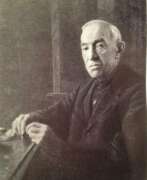

Nikolaу Petrovich Krymov (Russian: Никола́й Петро́вич Кры́мов), born on May 2, 1884, in Moscow, Russia, was a renowned Russian and Soviet painter and art theoretician, celebrated for his contributions to landscape painting and art education. Krymov hailed from an artistic family, and his education in the arts was comprehensive, studying under prominent figures like Abram Arkhipov, Nikolay Kasatkin, Leonid Pasternak, Valentin Serov, and Konstantin Korovin at the Moscow School of Painting, Sculpture and Architecture. His artistic journey began with participation in student exhibitions in 1906, and his works were soon featured in major exhibitions, including those of the Blue Rose, the Golden Fleece, and the Union of Russian Artists, marking his integration into significant artistic circles of his time.
Krymov's early works were significantly influenced by Isaac Levitan's delicate vision of Russian nature, focusing on the subtleties of daily transitions and the beauty of the Russian countryside. This influence is evident in Krymov's ability to convey the ethereal qualities of light and atmosphere in his landscapes, which were appreciated for their emotional depth and technical prowess. Among his notable works are paintings like "Dawn" (1908), "On the Mill" (1915), "First Snow" (1917), and "Hot Day" (1920), all of which demonstrate his masterful handling of light, shadow, and composition to capture the essence of nature.
Krymov's career also included significant contributions to art education and theory. He was an active participant in the "Blue Rose" movement, where he explored symbolism and impressionism, later transitioning towards a more classical approach in his landscapes. This evolution in style reflected his continuous search for an ideal harmony between reality and fantasy in his works. His dedication to art was recognized with several honors, including the title of Honorary Art Worker of the Russian Federation and the prestigious Order of the Red Banner of Labour.
Krymov's legacy extends beyond his paintings to include his influence on future generations of artists through his teaching and theoretical writings. His works are housed in museums and private collections, where they continue to be celebrated for their contribution to the landscape genre and Russian art.
For art collectors and experts interested in the rich tapestry of Russian landscape painting, Krymov's works offer a window into the soul of Russian nature and the artistic movements of the early 20th century. To stay updated on new product sales and auction events related to Nikolay Petrovich Krymov, signing up for updates is highly recommended. This subscription ensures that enthusiasts and collectors alike are informed about opportunities to acquire pieces by this illustrious artist, celebrating his enduring influence on the world of art.
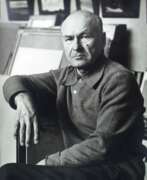

Yuri Petrovich Kugach (Russian: Юрий Петрович Кугач) was a prominent Russian artist, celebrated for his significant contributions to the realm of Soviet and Russian fine arts. His mastery in painting, especially within the genres of landscape and thematic works, marked him as a leading figure in the Russian realistic school of painting. Born in 1917, Kugach's artistic journey was distinguished by his dedication to portraying the natural and social landscapes of his homeland, earning him numerous prestigious titles and awards, including the People’s Artist of the USSR and the State Prize of the RSFSR named after I.E. Repin.
Kugach's works are known for their depth, expressiveness, and fidelity to the traditions of Russian realism. His celebrated pieces such as “On Saturday” and “Before the Dances” not only won him the State Prize of the RSFSR but also solidified his position as a steward of Russian artistic heritage. His art, deeply interwoven with the cultural and historical fabric of Russia, continues to attract attention and admiration, reflecting his lifelong commitment to exploring and depicting the essence of Russian life and nature.
As a key figure in Soviet and post-Soviet art, Yuri Kugach's legacy extends beyond his individual creations to include a dynasty of artists he inspired within his own family, fostering a lineage deeply rooted in the realistic portrayal of Russian subjects. His contributions to Russian art are celebrated through exhibitions and in collections both nationally and internationally, underlining the enduring appeal and significance of his work.
For collectors and experts in art and antiques, Kugach's oeuvre offers a rich tapestry of Soviet and Russian life through the lens of realism. His ability to capture the spirit of his subjects with authenticity and emotional depth makes his works highly sought after in the art world. To stay updated on new product sales and auction events related to Yuri Petrovich Kugach, sign up for updates and immerse yourself in the legacy of one of Russia's most revered artists.
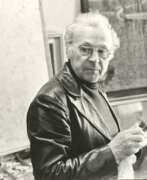

Andrey Ilyich Kurnakov (Russian: Андре́й Ильи́ч Курнаков) was a prominent Soviet and Russian artist, renowned for his contributions as a painter, graphic artist, and teacher. Born on October 5, 1916, in Oryol, Russian Empire, Kurnakov is celebrated for founding the Oryol art school, reflecting his deep connections to his homeland in the Oryol region of Russia. Throughout his illustrious career, he produced an extensive gallery of portraits, capturing both famous personalities and ordinary people with equal finesse. Kurnakov's artistic prowess was not limited to portraiture; he also excelled in creating epic battle scenes and decorating memorial complexes, showcasing his versatility and commitment to commemorating historical events.
His landscapes and genre portraits are particularly noted for their adherence to the traditions of Russian painting, blending realism and socialist realism to portray the vibrant and dynamic essence of Soviet life. Kurnakov's works are a testament to his skillful depiction of the human condition, the natural beauty of the Russian landscape, and the spirit of its people. His contributions to Russian art were recognized with numerous honors, including the prestigious titles of People's Artist of the USSR and People's Artist of the RSFSR, highlighting his significant impact on the art world.
Kurnakov's legacy continues to inspire, with his works held in high esteem and featured in various collections, including the State Tretyakov Gallery and the Oryol Regional Museum of Art. His dedication to art education, particularly through his teaching at the Oryol Pedagogical Institute, has left an indelible mark on generations of artists, perpetuating his influence within the Russian art community.
For collectors and experts in art and antiques, Kurnakov's oeuvre offers a unique glimpse into the heart of Soviet and Russian artistic expression, embodying the cultural, historical, and aesthetic values of his time. His works not only captivate with their technical excellence and emotional depth but also serve as a window into the evolving landscape of 20th-century Russian art.
If you're intrigued by the rich tapestry of Russian art history and the significant contributions of artists like Andrey Ilyich Kurnakov, consider signing up for updates on new product sales and auction events related to his work. Stay informed and enrich your collection with the profound and enduring legacy of one of Russia's most celebrated artists.
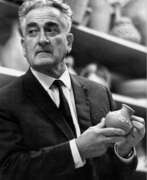

Apollon Karamanovich Kutateladze (Russian: Аполлон Караманович Кутателадзе) was a distinguished Soviet and Georgian artist, celebrated for his contributions to painting, graphic design, and pedagogy. Born in Georgia, Kutateladze's journey in art began at a young age, leading him to study under notable figures such as Eugene Lanceray, Gigo Gabashvili, and Iosif Adolfovich Charlemagne at the Tbilisi State Academy of Arts. His education was enriched by academic trips, including those to Leningrad, which broadened his artistic perspective.
Kutateladze's career was marked by a significant shift in teaching methodology at the Tbilisi State Academy of Arts, where he served as rector from 1959. Inspired by the principles of Walter Gropius and the Bauhaus, he introduced a new pedagogical approach that emphasized practical work and collaboration with industrial partners, moving away from classical art education methods. This innovative approach left a lasting impact on the academy, which was later renamed in his honor.
Throughout his lifetime, Kutateladze received numerous accolades, including the title of People's Artist of the USSR, and was awarded prestigious orders such as the Order of the Badge of Honour and the Order of the Red Banner of Labour. His works, which include a vast array of historical scenes and portraits, reflect a deep engagement with the cultural and political landscapes of his time. Notable works include "Comrade Stalin heading the Batumi workers' protest," "Conversation between comrade Stalin and the peasants of Adjara in 1902," and "March of Queen Tamara".
For collectors and experts in art and antiques, Kutateladze's legacy offers a rich tapestry of Soviet and Georgian art history, characterized by its pedagogical innovation and profound thematic depth. His works continue to be celebrated and studied, offering insights into the artistic movements and cultural dynamics of his era.
For more details and updates related to Apollon Karamanovich Kutateladze, including sales and auction events, signing up for updates is highly recommended. This subscription ensures that enthusiasts and collectors are always informed about the latest developments and opportunities related to Kutateladze's remarkable body of work.
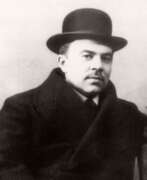

Pavel Kuznetsov (Russian: Павел Варфоломеевич Кузнецов) was a Russian artist, celebrated for his pioneering role in the Symbolist movement and his profound influence on the development of Russian modernist art. Born into the late 19th century, Kuznetsov's work spans painting, sculpture, and illustration, showcasing a unique blend of Eastern and Western artistic traditions.
Kuznetsov's art is renowned for its vibrant use of color, ethereal landscapes, and mystical themes. His distinctive style combines traditional Russian iconography with the innovative techniques of European modernism, making his work highly prized among collectors and art enthusiasts. Kuznetsov was a key member of the Blue Rose artist group, which sought to express the spiritual and emotional through art. This collective's contributions are considered seminal in the evolution of Russian Symbolism.
Among Kuznetsov's notable works are his dreamlike paintings of Central Asia, which brought a new dimension to Russian art by introducing themes and aesthetics from Eastern cultures. These pieces are not only significant for their artistic merit but also for how they reflect the cross-cultural exchanges of the early 20th century. Some of his masterpieces are held in prestigious institutions, including the Tretyakov Gallery and the Russian Museum, making them accessible to the public and subject to scholarly study.
For collectors and experts in the fields of art and antiques, Kuznetsov's works represent a valuable intersection of cultural heritage and artistic innovation. His contributions to the Symbolist movement and Russian modernism continue to inspire and influence contemporary art discourse.
To stay informed about new product sales and auction events related to Pavel Kuznetsov, sign up for our updates. This subscription is an excellent resource for collectors looking to enhance their collections with pieces by this distinguished artist. Join our community today and ensure you never miss an opportunity to acquire works by Pavel Kuznetsov.
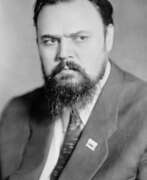

Aleksandr Ivanovich Laktionov (Russian: Александр Иванович Лактионов) was a distinguished Russian artist, celebrated for his intricate approach to painting and his ability to capture the essence of Soviet life through his art. Born in 1910, Laktionov's work spans a crucial period in Russian history, reflecting the cultural and social transformations of his time. He is renowned for his hyperrealistic paintings, which stand as a vivid chronicle of the era's ethos and its people's spirit.
Laktionov's artistry is marked by his meticulous attention to detail, a characteristic that has endeared him to art collectors and experts alike. His paintings are not just visual masterpieces; they are historical documents that offer a window into the daily lives of Soviet citizens, making him a vital figure in the study of Russian culture and art history. Among his most celebrated works is "A Letter from the Front," housed in the Tretyakov Gallery, Moscow. This painting is emblematic of Laktionov's ability to merge technical precision with deep emotional resonance, capturing the poignant realities of wartime Russia.
For collectors and experts in art and antiques, Laktionov's oeuvre represents an invaluable insight into the Soviet aesthetic and its underlying ideologies. His works are a testament to the enduring power of art to reflect and shape the narrative of its time. As interest in 20th-century Russian art continues to grow, Laktionov's paintings remain highly sought after, not only for their artistic merit but also for their historical significance.
We invite collectors and enthusiasts to sign up for updates related to Alexander Ivanovich Laktionov. Subscribing will keep you informed about new product sales and auction events featuring Laktionov's work. Rest assured, this subscription is focused solely on providing you with the latest opportunities to enhance your collection with pieces from one of Russia's most revered artists.
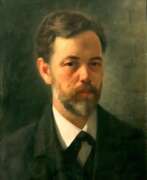

Andronik Grigorievich Lazarchuk (Russian: Андроник Григорьевич Лазарчук) was a Ukrainian and Soviet artist, born on January 15, 1870, in Ukhovetsk, Volhynian Governorate, and passed away on September 6, 1934, in Borzna, Chernihiv region. Known for his contributions to painting, teaching, and cultural activities, Lazarchuk's work primarily featured portraits, everyday scenes, and landscapes.
Lazarchuk began his artistic journey studying icon painting in Kovel and later in the Pochaev Lavra's painting workshop. From 1889 to 1897, he attended the Higher Art School at the Imperial Academy of Arts in St. Petersburg, where he studied under prominent artist Vladimir Makovsky. His artistic style was influenced by his early religious training, which is evident in his detailed and expressive portraits and landscapes.
One of his notable works, "Portrait of a Man," showcases his ability to capture human emotion and character. His other works include small-format paintings like "Reading a Letter" and "Family Group," which highlight his focus on everyday life and personal interactions. Lazarchuk also contributed to the decoration of Ukrainian churches, such as the Holy Trinity Church and the Cave Churches of Pochaev Lavra, and worked as an illustrator for magazines like "Native Land" and "Young Ukraine".
Collectors and art enthusiasts can explore Lazarchuk's legacy by signing up for updates on new product sales and auction events related to his works. This subscription will keep you informed about opportunities to acquire pieces by this influential artist.
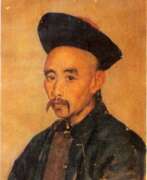

Anton Mikhailovich Legashov (Russian: Антон Михайлович Легашов) was a Russian artist of the first half of the 19th century. He is known as a painter, graphic artist and teacher.
Anton Legashov painted landscapes, portraits, genre paintings and still lifes. Many of them - using Chinese motifs and subjects. The painter lived more than 10 years in Beijing, where he was very popular with the local population for his work. He also created a series of religious paintings and icons for the Russian Spiritual Mission in Beijing.
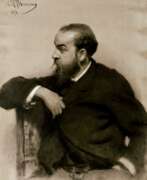

Rafail Sergeevich Levitsky (Russian: Рафаи́л Сергее́вич Леви́цкий) was a Russian artist of the last third of the 19th century to the first third of the 20th century. He is known as a painter-painter, photographer and teacher, professor of porcelain painting.
Rafail Levitsky painted genre paintings, portraits, landscapes, interiors, battle scenes from life. He is also considered the first artist in history to become a photographer. His many famous photographic portraits replaced models for painters, lithographers, illustrators, and engravers, as in the case of the portrait of Emperor Alexander III, which was reproduced on Russian banknotes.
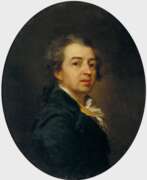

Dmitry Grigoryevich Levitzky (Russian: Дмитрий Григорьевич Левицкий) was an acclaimed Ukrainian-Russian portrait painter and academician born in May 1735, renowned for his exceptional contributions to the art of the 18th century. Originating from a family deeply rooted in the Ukrainian noble-priestly class, Levitzky's early exposure to art came from his father, Grigory Kirillovich Levitsky, a priest and an enthusiast in painting and engraving. This familial influence laid the foundation for Levitzky's artistic journey, which began in earnest when he assisted the prominent painter Alexey Antropov in Kiev, leading to his eventual move to Saint Petersburg.
Levitzky's rise to fame was marked by his unique ability to capture the essence of his subjects, combining exceptional technique with a fresh approach to portrait painting. His most notable works include portraits of significant figures from the Russian elite, such as Catherine II as the Legislatress in the Temple of the Goddess of Justice and portraits of the Smolny Institute's young ladies. Despite the grandeur and recognition that these works brought him, Levitzky faced financial struggles, spending his final years in poverty, a testament to the often-precarious nature of artistic acclaim.
His legacy, which had waned by the 19th century, was revitalized in the 20th century by art historian Alexander Benois, who positioned Levitzky among the pantheon of European Enlightenment artists. Levitzky's work is celebrated for its technical mastery and unique contribution to Russian and European portraiture, leaving an indelible mark on the artistic landscape of his time.
For collectors and experts in art and antiques, Levitzky's paintings are not just artistic achievements but also historical narratives captured in oil, reflecting the complex socio-cultural dynamics of 18th-century Russia. His portraits, housed in prestigious museums and galleries worldwide, continue to be studied and admired for their elegance, detail, and historical significance.
To stay updated on new findings and auction events related to Dmitry Grigoryevich Levitzky's works, sign up for updates. This subscription will ensure you're informed about sales and auctions where you can acquire pieces by this master portraitist, offering a unique opportunity to own a piece of art history.
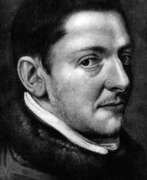

Anton Pavlovich Losenko (Russian: Антон Павлович Лосенко) was a Russian Neoclassical painter and academician of Ukrainian descent, celebrated for his historical subjects and portraits. Born in 1737 in Hlukhiv, Ukraine, and passing away in 1773 in Saint Petersburg, Russia, Losenko is recognized as a pivotal figure in the establishment of the Imperial Russian historical movement in painting. His education at the Imperial Academy of Arts and under Jean II Restout in Paris honed his skills, leading to masterpieces that blend Neoclassicism with humane narratives.
Losenko's legacy includes influential works such as the "Miraculous Catch of Fish" and the "Vladimir and Rogneda," reflecting his deep engagement with classical and biblical subjects as well as Russian history. This painter also contributed significantly to art education in Russia, authoring "Short Explanation of the Human Proportions," a textbook that educated generations of Russian artists. His students included notable names like Ivan Akimov, Grigory Ugrymov, and sculptor Mikhail Kozlovsky, indicating his lasting impact on Russian art.
His works, celebrated for their neoclassical style and emotional depth, are essential for understanding the evolution of Russian and European art. Losenko's role as a founder of Russian historical painting and his innovative approach to art education mark him as a key figure in art history. His paintings can be found in prominent museums and galleries, showcasing his significant contribution to the art world.
For collectors and experts in art and antiques, Losenko's work represents a fascinating intersection of Russian history, neoclassicism, and pedagogy in art. To stay updated on sales and auction events related to Losenko's works, signing up for updates can provide exclusive access to the latest information on this influential artist's pieces.
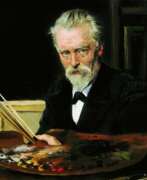

Vladimir Yegorovich Makovsky (Russian: Владимир Егорович Маковский), a distinguished Russian artist born in 1846 in Moscow, was celebrated for his genre paintings that vividly depicted everyday life with a blend of humor and social critique. His father, Yegor Ivanovich Makovsky, co-founded the Moscow School of Painting, Sculpture, and Architecture, where Vladimir later studied and taught, shaping the future of Russian art alongside his artistic family.
Makovsky's work often showcased small-town scenes and common folk, creating narratives that were both endearing and pointedly critical of societal injustices. Noteworthy pieces like "The Grape-juice Seller," "Fruit-Preserving," and "The Congratulator" highlight his skill in capturing the nuances of human expressions and interactions.
Throughout his career, Makovsky remained a pivotal member of the Peredvizhniki (Wanderers), a group dedicated to portraying real-life issues through art. His later works, such as "The Peddler" and "January 9, 1905, on Vasilyev Island," reflect his continued commitment to social themes, depicting historical events with deep empathy for the oppressed.
For art enthusiasts and collectors, Makovsky's works are pivotal in understanding the evolution of Russian realism. His paintings are held in high esteem and are featured in major museums around the world. To stay updated on exhibitions and sales related to Vladimir Yegorovich Makovsky, sign up for our newsletter, focusing exclusively on significant updates from the art world.
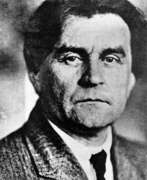

Kazimir Severinovich Malevich (Russian: Казимир Северинович Малевич) was a pioneering Russian artist, known for his profound influence on the development of abstract art in the 20th century. His nationality and specializations in painting, art theory, and teaching have cemented his place as a pivotal figure in the avant-garde movement, particularly for his role in founding the Suprematism movement. This movement, characterized by its focus on basic geometric shapes and a limited color palette, aimed to convey the supremacy of pure artistic feeling over the depiction of objects.
Malevich's art and theories have had a lasting impact on the course of modern art, challenging traditional perceptions of form and composition. His most famous work, "Black Square," epitomizes the essence of Suprematism. It represents a radical break from past art forms and a move towards abstraction, where the emotional and spiritual dimensions of art are prioritized. This piece, along with others like "White on White," has been exhibited in prestigious museums and galleries worldwide, showcasing Malevich's enduring legacy.
For collectors and experts in art and antiques, Malevich's works are not just paintings but are significant historical artifacts that embody a transformative period in art history. His contributions extend beyond his canvases, influencing sculpture, culture, and the broader artist school. His innovative approach to art has paved the way for future generations of artists, making his works highly sought after in the art and antique collecting community.
For those interested in the avant-garde movement and the evolution of abstract art, staying informed about Kazimir Malevich's contributions is essential. We invite you to sign up for updates related to Malevich, including notifications on new product sales and auction events. This subscription will keep you at the forefront of the latest discoveries and opportunities to acquire pieces connected to this revolutionary artist.
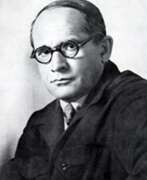

Matvey Genrikhovich Manizer (Russian: Матвей Генрихович Манизер) was a distinguished Russian sculptor, celebrated for his contributions to socialist realism. Born on March 17, 1891, in Saint Petersburg, Manizer emerged from a family deeply rooted in the arts, his father being a renowned Baltic German artist. His educational journey at the Saint Petersburg State Artistic and Industrial Academy and the art school of the Peredvizhniki honed his skills, leading him to become a seminal figure in Soviet art. Manizer's move to Moscow in 1941 marked a pivotal phase in his career, where he continued to produce significant works that were distributed across the Soviet Union, including multiple portrayals of Lenin.
Manizer's style, deeply academic and realistic, was instrumental in capturing the ethos of an era, making him a key proponent of socialist realism. His monumental works, such as the Monument to V. Volodarsky in Leningrad and the series of 80 bronzes for the Moscow Metro station Ploshchad Revolyutsii, are testaments to his mastery and ideological commitment. His achievements earned him the title of People's Artist of the USSR in 1958, among other accolades, highlighting his influence in the Soviet art scene.
The legacy of Matvey Manizer is not just limited to his sculptures; it extends through his family, with his wife Yelena Yanson-Manizer and their son Gugo Manizer continuing the artistic tradition. Manizer's work remains a pivotal part of Russian cultural heritage, exhibited in various public spaces and commemorating figures and events that shaped Soviet history.
For collectors and experts in art and antiques, Manizer's work offers a deep dive into the artistic narratives of the 20th century, especially within the Soviet context. His sculptures serve as historical markers, blending artistic merit with ideological narratives. For those interested in exploring more about Manizer's contributions and his role in Soviet art, subscribing for updates on new product sales and auction events related to Matvey Genrikhovich Manizer is highly recommended. This subscription will keep you informed about opportunities to own a piece of this monumental artist's legacy.
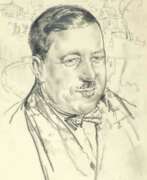

Ilya Ivanovich Mashkov (Russian: Илья Иванович Машков) was a Russian artist, renowned for his vivid and sensory-rich paintings, embodying the essence of Russian Neo-Primitivism. His journey began in the village of Mikhailovskaya, propelling from a humble background to becoming one of the most significant figures in the "Jack of Diamonds" group. His works are celebrated for their tangible, almost tactile quality, drawing viewers into a vivid world where colors pop and forms pulse with life.
Mashkov's notable participation in significant exhibitions across Europe and the United States, including the Salon d'Automne and the Venice Biennale, helped cement his status in the art world. One of his masterpieces, "Still Life with Fruit," fetched a record $7.3 million at a Christie's auction in 2013, underlining his critical and commercial acclaim. This painting, a prime example of Russian Neo-Primitivism, was unveiled at the inaugural Jack of Diamonds exhibition, highlighting Mashkov's pioneering role in Russian Avant-Garde.
Mashkov's contributions extended beyond his canvas; he was a dedicated educator, establishing his art school and later teaching at VKhUTEMAS. His influence is palpable in the collections of major museums, including the Russian Museum, which houses a diverse array of his works from vibrant still lifes to expressive portraits.
For collectors and experts in art and antiques, Mashkov's legacy offers a captivating glimpse into the evolution of Russian modernism. His works, characterized by their bold coloration and dynamic composition, continue to inspire and attract admiration worldwide.
To stay updated on sales and auction events featuring Ilya Ivanovich Mashkov's work, signing up for updates is highly recommended. This ensures you're always informed about the latest opportunities to acquire pieces by this master of Russian Neo-Primitivism.
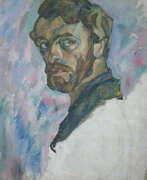

Adolf Izrailevich Milman (Russian: Адольф Израилевич Мильман) was a Russian and French painter, born in 1886 in Kishinev, then part of the Russian Empire, into a large Jewish family. He initially studied at a commercial school in Kishinev before moving with his family to Moscow in the early 1900s, where he entered the Moscow School of Painting, Sculpture, and Architecture. Milman's early career was marked by his attendance at the art studio of Ilya Mashkov, a significant influence and a close friend. He was deeply involved in the Russian avant-garde art scene, becoming a member of the Jack of Diamonds group in 1911 and later joining the World of Art association along with notable artists like Robert Falk and Alexander Lentulov.
Milman's work was characterized by his engagement with the Jack of Diamonds group, where he exhibited his pieces in their group exhibitions between 1912 and 1914. His artworks from this period include vibrant landscapes and still lifes, reflecting the avant-garde movements of the time. By 1917, he had joined the World of Art association, contributing to its exhibitions and emphasizing his evolving artistic style. Beyond his creation, Milman also dedicated time to teaching at Ilya Mashkov's private studio of painting and drawing until his health was compromised by tuberculosis, leading him to seek treatment in Crimea annually from 1914.
Milman's later years saw him move to France, where he continued to participate in the Russian art exhibitions in Paris and the Hague, further cementing his role in the broader European art scene until his death in 1930.
For collectors and experts in art and antiques, Milman's work represents a bridge between Russian and French avant-garde art movements, embodying the vibrant cultural exchanges of the early 20th century. His pieces, often displayed in museums and galleries, offer a glimpse into the dynamic art scene of his time.
To stay updated on works and auction events related to Adolf Izrailevich Milman, consider signing up for updates. This subscription will alert you to new product sales and auction events, ensuring you don't miss an opportunity to appreciate or acquire pieces by this influential artist.
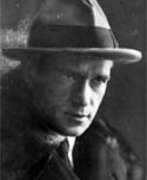

Efim Semyonovich Minin (Russian: Ефим Семёнович Минин) was a Belarusian artist of the first half of the twentieth century. He is known as a painter, graphic artist and teacher.
Efim Minin created portraits, worked in woodblock printing technique, was engaged in exlibris. One of the leading themes of the artist's work was the cityscapes of his native Vitebsk, which he used for many exlibris. His artistic legacy includes several series of woodcuts dedicated, in particular, to Vitebsk and the monuments of the wooden civilization of Belarus.
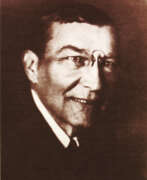

Dmitry Isidorovich Mitrohin (Russian: Дмитрий Исидорович Митрохин) was a distinguished Russian and Soviet graphic artist, illustrator, and master of various graphic arts, including easel engraving, etching, and lithography. Born in the city of Yeysk, Krasnodar Krai, and later residing in Leningrad and Moscow, Mitrohin's journey in the arts took him from the Moscow school of painting to private schools in Paris, and finally to St. Petersburg, where he immersed himself in the artistic circle of the "World of Art" association. Throughout his career, Mitrohin became known for his profound contributions to book graphics, thanks to his early work with S. I. Yaguzhinsky, which paved the way for his prolific output as a book illustrator. His style, recognized for its impeccable graphic finesse and harmonious unity of drawings, inscriptions, and ornamentation, set a high standard in Russian book arts during the early 20th century.
Mitrohin's illustrations graced the pages of numerous children's books, among them "Little Flour" by V. Hauff, "Roland-squire" by V. A. Zhukovsky, and "The Barge" by R. Gustafson, each exemplifying the artist's dedication to refined graphic expression. His contributions extended beyond illustration, as he played a significant role in curating and teaching, particularly at the Russian Museum and through various educational endeavors. His work, marked by a transition from adherence to established canons to a more liberated stylistic expression, showcased his evolving interests and mastery over graphic arts. His engagement with printed motifs and the exploration of different graphic techniques underscored a lifelong commitment to artistic innovation and excellence.
For collectors and experts in art and antiques, Mitrohin's work represents a pivotal moment in the history of Russian graphic arts, offering insights into the transformation of book illustration and the broader visual culture of the era. His legacy, embodied in the rich collection of book illustrations and graphic works, continues to inspire admiration and scholarly interest.
To stay updated on exhibitions, sales, and auction events related to Dmitry Isidorovich Mitrohin's work, signing up for updates is a practical way to ensure you don't miss out on the opportunity to engage with the history and artistry of one of Russia's significant graphic artists.
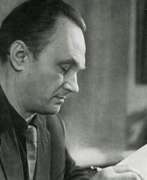

Dmitry Konstantinovich Mochalsky (Russian: Дмитрий Константинович Мочальский) was a Soviet Russian painter and graphic artist, celebrated for his contributions to art from 1908 until 1988. Born in St. Petersburg, he became a pivotal figure in Russian art, especially known for his engagement with themes of Soviet life and the representation of the common man. Mochalsky's education was underpinned by his studies at the Leningrad Academy of Arts, where he was influenced by K. Petrov-Vodkin, and his teaching career at the Moscow Institute of Fine Arts from 1937, where he became a professor in 1950.
His works, which include a vast array of paintings and sketches, often depicted the Soviet ethos through scenes of daily life, heroism, and the landscapes of the USSR, including notable works from his travels in Western Europe and Vietnam. Mochalsky's art was characterized by its lyrical genre scenes, particularly his virgin lands series, which celebrated the Soviet youth's efforts in agriculture during the "thaw era". This period in his oeuvre is marked by a freer painting style and a revival of color traditions tracing back to the early 20th century, moving away from the heroic canvases of earlier Soviet art. His significant contributions to Soviet art were recognized with several honors, including the title of People's Artist of the USSR in 1980 and the I.E. Repin State Prize of the RSFSR in 1967.
Mochalsky's legacy is preserved in the collections of Russia's most esteemed museums, such as the State Tretyakov Gallery, the Pushkin Museum, and the State Russian Museum, ensuring his work remains influential and accessible for future generations to study and appreciate.
For collectors and experts in art and antiques, Dmitry Konstantinovich Mochalsky’s works offer a captivating glimpse into the Soviet era's artistic richness and thematic diversity. His paintings not only depict the Soviet Union's social and cultural landscape but also embody the spirit of an era that sought to define itself through its art.
If you're intrigued by Mochalsky's work and wish to delve deeper into the world of Soviet art, consider signing up for updates on new product sales and auction events related to Dmitry Konstantinovich Mochalsky. This subscription will keep you informed on opportunities to acquire pieces by Mochalsky and learn more about exhibitions featuring his work.
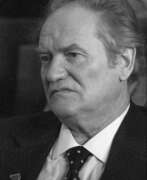

Yevsey Yevseyevich Moiseyenko (Russian: Евсе́й Евсе́евич Моисе́енко) was a distinguished Soviet and Russian artist, born in 1916 in Uvarovichi, near Gomel, then part of the Russian Empire. His early interest in art led him to enroll at the Moscow Industrial Art College in 1931, laying the foundation for a prolific career in painting. Moiseyenko's journey continued at the Repin Institute of Painting, Sculpture and Architecture, where he studied under notable instructors, including Alexander Osmerkin. His experiences during World War II, including his time as a prisoner of war, deeply influenced his thematic focus on heroic battles and the resilience of the Soviet people during wartime.
Moiseyenko's work is renowned for its emotional depth and expressive style, particularly visible in his series "The Years of Fighting," which reflects on World War II. His paintings, such as "Red Came," "Mother, Sister," and "Yesenin with his Grandfather," showcase a transition from Soviet Realism to a more abstract and emotionally charged approach. This evolution in style, coupled with his use of vivid colors and dynamic compositions, solidified his reputation as a leading figure in Soviet art. Moiseyenko's contributions to art were recognized with numerous awards, including the title of People's Artist of the USSR and the Lenin Prize.
His artworks, rich with historical and cultural references, are held in high esteem and can be found in major Russian museums, including the State Russian Museum and the Tretyakov Gallery. Moiseyenko's legacy extends beyond his paintings; as a professor at the Repin Institute, he influenced generations of artists, sharing his vision and understanding of art's power to express the human condition.
For collectors and experts in art and antiques, Moiseyenko's work represents a pivotal intersection of Soviet history, personal narrative, and artistic evolution. His ability to capture the essence of Soviet life and the spirit of its people during times of turmoil and peace alike offers a profound perspective on the 20th century.
To stay updated on new discoveries, sales, and auction events related to Yevsey Yevseyevich Moiseyenko's work, signing up for updates is highly recommended. This ensures access to the latest information and opportunities to acquire pieces by this eminent artist, whose work continues to inspire and captivate audiences around the world.
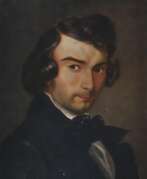

Apollon Nikolaevich Mokritsky (Russian: Аполлон Николаевич Мокрицкий) was a Ukrainian-Russian painter and art educator, known for his contributions to the 19th-century art scene. Born in 1810 in Pyryatyn, Ukraine, Mokritsky became an influential figure in Russian academic art, specializing in portrait and historical painting.
Mokritsky's work is celebrated for its detailed realism and emotional depth. His portraits often capture the essence of his subjects, showcasing his skill in rendering lifelike expressions and intricate details. One of his most notable works is the portrait of the renowned Russian poet, Taras Shevchenko, which exemplifies his ability to combine technical precision with profound sensitivity.
In addition to his painting, Mokritsky played a significant role as an educator. He taught at the Moscow School of Painting, Sculpture and Architecture, where he mentored many young artists who would go on to shape Russian art. His influence extended beyond his own works, helping to cultivate a new generation of artists.
Today, Mokritsky's paintings can be found in various museums and galleries, including the Tretyakov Gallery in Moscow. His contributions to art and education continue to be recognized and celebrated by art collectors and historians alike.
Sign up for updates to learn more about new product sales and auction events related to Apollon Nikolaevich Mokritsky.
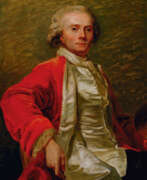

Jean-Laurent Mosnier was a French painter and miniaturist, renowned for his detailed and polished portraitures during the Ancien Régime. Born in Paris in 1743, Mosnier quickly ascended to become a court painter, notably serving Marie Antoinette. His mastery in miniature painting earned him significant acclaim, leading to a prosperous career across various European cities, including London, Hamburg, and St. Petersburg, after fleeing France due to the Revolution.
Mosnier's works are recognized for their exquisite attention to texture and fabric, skills likely honed during his early training at the Académie de Saint-Luc. He became a member of the Académie Royale in 1788, where his works, such as portraits of prominent academicians, solidified his reputation. His career spanned various shifts in his geographical and political contexts, adapting his artistic style to suit the tastes of his diverse clientele, including various European aristocrats and members of the Russian imperial family.
Several of Mosnier's significant works are housed in prestigious museums, including the Louvre and The Metropolitan Museum of Art, ensuring his legacy within the annals of European art history. For art collectors and enthusiasts interested in the rich history and exquisite craftsmanship of Jean-Laurent Mosnier's works, keeping updated on exhibitions and sales is invaluable. Sign up for updates on new product sales and auction events related to Jean-Laurent Mosnier to enhance your collection and appreciation of this distinguished artist.
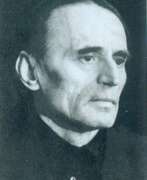

Alexander Petrovich Mozolev (Russian: Александр Петрович Мозолёв) was a Belarusian Soviet artist of the second third of the twentieth century. He is known as a painter, graphic artist and teacher.
Alexander Mozolev worked in easel painting and graphics - in landscape, portrait, everyday life and battle genres. Many of his thematic paintings were devoted to the Great Patriotic War, in which the artist participated. Among his creative heritage are also many sketches, studies and sketches.
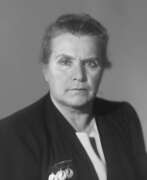

Vera Ignatyevna Mukhina (Russian: Ве́ра Игна́тьевна Му́хина) was a renowned Soviet sculptor and artist, celebrated for her significant contributions to Soviet art and sculpture. Born into a wealthy merchant family in Riga, Mukhina's journey into the world of art took her through the studios of notable artists in Russia and Europe, including the Académie de la Grande Chaumière in Paris under Antoine Bourdelle. Her work is deeply imbued with a sense of national pride and a commitment to the socialist cause, reflecting the tumultuous times she lived through, including both World Wars and the shifting political landscape of the Soviet Union.
Mukhina's most celebrated piece, "Worker and Kolkhoz Woman," a towering sculpture made of stainless steel, was originally created for the 1937 World's Fair in Paris. This sculpture, standing as a symbol of Soviet might and unity, showcases Mukhina's mastery in welding and her innovative approach to monumental art. The piece was acclaimed internationally and continues to be a significant symbol of Soviet and Russian culture.
Throughout her career, Mukhina experimented with a variety of materials and techniques, including glass, earning her numerous awards, such as the Stalin Prize, which she received five times, and the title of People's Artist of the USSR. Her commitment to art went beyond her own creations; she was a passionate educator and theorist, advocating for the enrichment of Soviet artistic vocabulary and experimenting with new materials and forms.
Mukhina's legacy extends beyond her sculptures to her contributions to the art world through her theoretical writings, her influence on public and architectural sculpture, and her experimentation with art glass, transforming ordinary objects into decorative art pieces. Her works are preserved in museums and public spaces, continuing to inspire and evoke admiration.
For collectors and experts in art and antiques, Mukhina's works represent a poignant narrative of 20th-century Soviet art, characterized by its boldness, innovation, and ideological commitment. Her life's work offers a window into the complexities of Soviet art, navigating the realms of personal expression and state expectations.
For those interested in exploring Vera Ignatyevna Mukhina's significant contributions to art and sculpture, consider signing up for updates on new product sales and auction events related to her work. This subscription offers a unique opportunity to engage with the history and legacy of one of the 20th century's most influential artists.
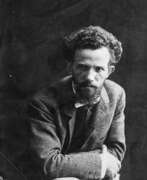

Oleksandr A. Murashko (Russian: Александр Александрович Мурашко) was a prominent artist of Russian and Ukrainian descent, renowned for his profound contributions to painting and art education. Born on August 26, 1875 in Kiev, Murashko's journey in art began at the prestigious St. Petersburg Academy of Arts, after which he honed his skills in Europe, including Paris and Munich. His determination led to the founding of the Kiev Art Academy, a milestone in the history of Ukrainian culture.
Murashko's art is characterized by a vivid depiction of light and shadow, a technique he honed during his acquaintance with Impressionism in Paris. His preference to paint intimate acquaintances rather than commissioned portraits added an individuality that resonated deeply with the art community. Despite his tragic death in 1919, Murashko's legacy lives on, notably through a special room in the National Art Museum of Ukraine and a monument on a Ukrainian bank coin in 2015, highlighting his cultural significance.
Characterized by a unique blend of realism and impressionism, his work reflected his deep connection to his roots and keen observation of light and life. The tragic end of his life, victimized by political upheaval, cut short a promising career, but his influence on Ukrainian art remains indelible.
For collectors and experts in art and antiques, Oleksandr A. Murashko's works represent not only aesthetic beauty, but also a rich historical narrative. His paintings are a testament to the resilience and creativity of an artist who has overcome the complexities of cultural identity through his art. To keep abreast of new sales and auction events featuring Murashko's work, we invite you to subscribe for updates. With this subscription, you will always be aware of all events related to this outstanding artist and will celebrate his enduring legacy in the art world.
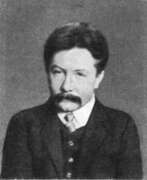

Pyotr Yevgenyevich Myasoyedov (Russian: Пётр Евгеньевич Масоедов) was a Russian artist of the late 19th and early 20th centuries. He is known as a painter who worked in the historical and religious genres, as well as a teacher.
Pyotr Myasoyedov, as a painter, at the beginning of his career became famous for the painting "The Burning of Protopop Avvakum". The creative heritage of the artist also includes the frescoes in the Church of St. Alexander Nevsky in Sofia, in the creation of which the master was involved.
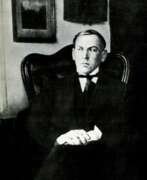

George Ivanovich Narbut (Russian: Георгий Иванович Нарбут) was a Ukrainian graphic artist, celebrated for his seminal contributions to the visual identity of the Ukrainian People's Republic through his designs of its coat of arms, banknotes, postage stamps, and charters. Born in 1886 in Narbutivka, now in Ukraine, Narbut hailed from a family with ancient Lithuanian nobility roots. He was self-taught before honing his skills in Saint Petersburg under the guidance of Ivan Bilibin and Mstislav Dobuzhinsky, and further education in Munich. His works are known for blending the simplicity of lines with sophistication in composition, marked by a distinctive style that pays homage to Ukrainian Baroque and Russian classicism with a touch of secessionist flair.
Narbut's creativity wasn't confined to graphic arts alone; he explored book illustration, including works for Hans Christian Andersen and Ivan Krylov, as well as creating toys, furniture designs, and silhouette portraits, showcasing his broad artistic talents. His influence extends beyond his lifetime, impacting generations of Ukrainian graphic designers and contributing to the branding of modern Ukraine.
Narbut's legacy is preserved in various museums and galleries, evidencing his role as a pioneer of Ukrainian graphic arts and his profound influence on the field. His artworks, such as the "Ukrainian Alphabet" and illustrations for classic literature, continue to inspire admiration and study for their historical significance and artistic merit.
Collectors and experts in art and antiques recognize Narbut's unique contribution to the Ukrainian cultural heritage and the broader art world. His life and work embody the vibrant intersection of national identity and artistic innovation, making him a figure of enduring interest.
If you're passionate about the art and history of George Ivanovich Narbut, sign up for updates to stay informed about new product sales and auction events related to his work. This subscription is your gateway to exploring the timeless beauty and significance of Narbut's contributions to art and national identity.
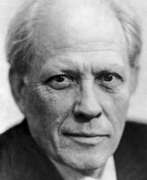

Yuri Mikhailovich Neprintsev (Russian: Ю́рий Миха́йлович Непри́нцев) was a celebrated Soviet and Russian painter, a distinguished member of the Academy of Arts of the USSR, and a professor at the Repin Institute of Arts. Born in 1909, Neprintsev's work is a vivid representation of Soviet life, encapsulating moments of history with a profound sense of realism and emotional depth. His participation in World War II as a volunteer not only influenced his thematic focus but also lent a genuine authenticity to his depictions of battle and everyday heroism.
Neprintsev's most renowned painting, "Rest after the battle," earned him the prestigious Stalin Prize in 1952. This work, along with others like "The Last Grenade" and "The Story of the Father," are poignant narratives of the Soviet spirit during trying times. His early works, such as “Conclusion of a contract for socialist competition,” created in 1939, showcased his ability to capture life's unscripted moments, portraying them with an immediacy that engages the viewer directly.
Over his long and storied career, Neprintsev was honored with numerous awards, including the Order of the Red Star, the Order of Lenin, and the title of People's Artist of the USSR. His paintings are held in prestigious collections worldwide, including the State Russian Museum and the State Tretyakov Gallery, reflecting his significant impact on Russian and Soviet art.
Neprintsev's legacy extends beyond his own creations; he was a dedicated teacher, shaping the next generation of artists at the Repin Institute of Fine Arts from 1948 until his passing in 1996. His influence on students like LA Rusov and E. V. Kozlov underscores his role in perpetuating the rich tradition of Russian painting.
For collectors and art enthusiasts interested in exploring the depth and breadth of Soviet-era art, Yuri Mikhailovich Neprintsev's work offers a compelling narrative of resilience, beauty, and the human spirit under the pressures of war and societal change. Sign up for updates on new product sales and auction events related to Yuri Mikhailovich Neprintsev, and discover more about this remarkable artist whose work continues to inspire and resonate across generations.
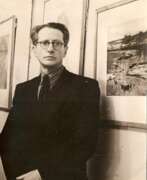

Samuil Grigorievich Nevelshtein (Russian: Самуил Григорьевич Невельштейн) was a distinguished Soviet Russian painter, watercolorist, graphic artist, and art teacher, known for his impactful role in the Leningrad school of painting. Born on March 22, 1903, in Kherson, Ukraine, then part of the Russian Empire, Nevelshtein made a significant mark in the art world with his expressive portraits and scenes reflecting Soviet life.
Nevelshtein's journey in the arts began at VKhuTeMas, a renowned Moscow art school, where he honed his skills before moving to Leningrad. There, he graduated from the Proletarian Institute of Fine Arts and became a pivotal member of the Leningrad Union of Artists from 1935. His artwork primarily includes portraits, genre compositions, and landscapes, showcasing his mastery in both watercolors and oil painting.
His works are held in high esteem and are part of collections in major museums and private collections across the globe, including the State Russian Museum. Nevelshtein's exhibitions were well-received, contributing significantly to the cultural tapestry of Leningrad, now Saint Petersburg, until his death on November 16, 1983.
For those interested in exploring the works of Samuil Nevelshtein or learning about upcoming auctions and exhibitions featuring his art, consider subscribing for updates. This will ensure you are informed about new sales and auction events related to Nevelshtein's works, enhancing your collection and knowledge of this influential artist.
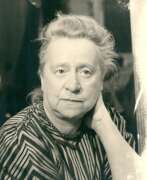

Nina Ilinichna Niss-Goldman (Russian: Нина Ильинична Нисс-Гольдман) was a Russian sculptor, born in 1893 in Rostov-on-Don. She embarked on her artistic journey in Kiev, where she began studying sculpture at the end of her secondary education. In 1911, Niss-Goldman moved to Paris to further her studies in sculpture for three years. This period was crucial for her development as an artist, allowing her to immerse herself in the vibrant artistic community of Paris. By 1915, she started participating in exhibitions in Moscow, marking the beginning of her professional career. Niss-Goldman's contributions to art did not stop at her creations; from 1925 to 1930, she shared her knowledge and skills by teaching at Vhuteine, influencing the next generation of artists.
Niss-Goldman's artistry was not confined to a single theme or style. Instead, she experimented with form and was closely associated with notable figures like Eli Nadelman and Hannah Orlova during her time in Paris between 1910 and 1915. Her work was known for its power and distinction, much like that of her contemporary, Beatrice Sandomirskaya. Niss-Goldman's statues and sculptures stood out for their compelling expression and technical mastery, making a significant impact in the art world.
For collectors and experts in art and antiques, Nina Ilinichna Niss-Goldman represents a fascinating figure whose works reflect a rich tapestry of influences and innovations. Her journey from Rostov-on-Don to Paris and then Moscow encapsulates a pivotal era in art history, marked by experimentation and a quest for new expressions. Her legacy, as both an artist and teacher, continues to inspire and captivate audiences.
To stay updated on exhibitions, sales, and auction events related to Nina Ilinichna Niss-Goldman, sign up for updates. This subscription is an excellent way for enthusiasts and collectors to remain informed about opportunities to engage with her work and learn more about her contributions to art.
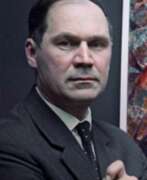

Evald Okas (Russian: Эвальд Карлович Окас) was an esteemed Estonian painter, celebrated for his profound contribution to art, particularly through his captivating portraits of nudes. Born in Tallinn in 1915, Okas embarked on his artistic journey at the State Art School, where the tumultuous era of World War II and the subsequent Soviet invasion of Estonia deeply influenced his path. These events led him to join the Soviet army and eventually become part of the artistic collectives organized in the Soviet rear in Yaroslavl, Russia, where he honed his skills under the mentorship of significant figures such as Aino Bach and Richard Sagrits.
Throughout his career, Okas displayed a remarkable versatility, dabbling in socialist realism during his early years, particularly noted in his work alongside Elmar Kits and Sagrits in painting the ceiling of the Estonian National Opera. However, by the late 1950s, he shifted towards working primarily in charcoals, creating ex libris and exploring freer artistic expressions. This period marked a significant evolution in his art, allowing him to exhibit across the Soviet Republics and internationally, showcasing his ability to capture the essence of his subjects with a profound depth and sensitivity.
Notably, Okas's work took a lyrical turn during his time on Kihnu Island, where he painted numerous portraits of fishermen and islanders, reflecting a more picturesque and liberated brushwork. These works are celebrated for their naturalistic portrayal of everyday life, imbued with a sense of warmth and intimacy that characterizes Okas's approach to his subjects.
Evald Okas's legacy extends beyond his own contributions to include the artistic endeavors of his son, Jüri Okas, an architect, installation artist, and printmaker, ensuring the continuation of the Okas family's impact on the art world. His works remain a significant part of Estonia's cultural heritage, offering insight into the country's historical and social narrative through the lens of one of its most talented artists.
For collectors and experts in art and antiques, the exploration of Evald Okas's oeuvre offers a unique window into the evolution of Estonian art through the 20th century. To stay updated on sales and auction events featuring Okas's work, signing up for updates is highly recommended. This subscription ensures access to the latest information on opportunities to acquire pieces by this remarkable artist, further enriching the appreciation of Estonia's rich artistic legacy.
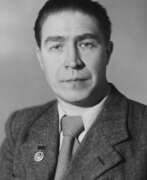

Victor Mikhailovich Oreshnikov (Russian: Виктор Михайлович Орешников) was a Soviet and Russian painter, celebrated for his contributions to the realm of realist art. Born on January 20, 1904, in Perm and passing away on March 15, 1987, in Leningrad, Oreshnikov left an indelible mark on the art world through his profound depictions of Soviet life, historical narratives, and captivating portraits. His dedication to capturing the essence of his subjects earned him the titles of People's Artist of the USSR and a member of the Soviet Academy of Arts, highlighting his esteemed position within the artistic community.
Oreshnikov's education at the Leningrad VHUTEIN under the guidance of Kuzma Petrov-Vodkin shaped his artistic vision, allowing him to explore various genres including portraits, genre scenes, historical compositions, and landscapes. His works are characterized by their nuanced exploration of human emotions and the socio-political context of his times. Oreshnikov’s role as a professor and rector at the Repin Institute of Arts further solidified his influence, nurturing a new generation of artists.
Throughout his career, Oreshnikov’s art was showcased in personal exhibitions across major cities like Leningrad and Moscow, attesting to his widespread acclaim. His ability to imbue female portraits with grace and femininity, alongside serene landscapes that captured the harmony of the natural world, distinguished his work. Notably, his family, including his son and granddaughter, continued his artistic legacy, underscoring the lasting impact of his oeuvre. Today, Oreshnikov's masterpieces are housed in prestigious institutions such as the State Tretyakov Gallery and the State Russian Museum, ensuring that his contributions to Soviet and Russian art are remembered and celebrated.
For those intrigued by the life and works of Victor Mikhailovich Oreshnikov, delving into his diverse body of work offers a unique glimpse into the evolution of Soviet art and its enduring influence on contemporary practices. His dedication to realism and the profound humanity evident in his portraits and landscapes make his work a significant study for collectors and experts alike. To stay updated on exhibitions and sales related to Oreshnikov’s work, signing up for updates is highly recommended, offering exclusive insights into the vibrant legacy of this distinguished artist.
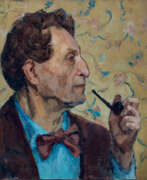

Alexander Alexandrovich Osmerkin (Russian: Александр Александрович Осмёркин) was a Russian avant-garde artist celebrated for his contributions to the development of Russian art in the early 20th century. His journey into the arts was deeply influenced by his childhood exposure to art and literature, which was nurtured by his family and the artistic environment of Moscow, where he later moved to study and work. Osmerkin's early fascination with the works of great artists like Vrubel and his admiration for Pushkin's poetry significantly shaped his artistic development.
Throughout his career, Osmerkin was an influential figure in the Russian avant-garde movement, closely associated with the "Jack of Diamonds" group. His work displayed a vibrant expression of color and form, which he explored alongside notable contemporaries such as Ilya Mashkov and Pyotr Konchalovsky. Osmerkin's versatility spanned painting, graphic art, stage design, and art teaching, leaving a lasting impact on the Soviet art scene. His dedication to art education saw him teaching at prestigious institutions like VKhUTEMAS and the Surikov Institute of Fine Arts in Moscow, influencing a generation of artists.
Despite facing significant challenges during the Stalin era, including accusations of formalism and a ban from teaching and exhibiting, Osmerkin's creative spirit remained undiminished. He continued to produce a vast body of work, including over 700 pieces, ranging from landscapes to still lifes, which are now housed in major Russian museums like the Tretyakov Gallery, the Museum of Fine Arts in Moscow, and the State Russian Museum in St. Petersburg.
For collectors and experts in art and antiques, Alexander Alexandrovich Osmerkin's work represents a critical link in the evolution of Russian avant-garde art, offering insights into the cultural and political landscape of early 20th-century Russia. His legacy continues to inspire and captivate audiences, underscored by his profound influence on his students and the broader artistic community.
For updates on exhibitions and auction events featuring Alexander Alexandrovich Osmerkin's work, sign up for our newsletter. Stay informed on the latest sales and discover the rich history of this pivotal figure in Russian avant-garde art.
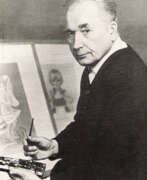

Alexei Fedorovich Pakhomov (Russian: Алексей Фёдорович Пахомов) was a distinguished Russian avant-garde painter and graphic artist, celebrated for his mastery in lithography and profound contributions to children's book illustrations. Born in Varlamovo, Vologda Province, in 1900, Pakhomov's artistic journey commenced at the Stieglitz Art School in Petrograd and extended through the Vkhutemas under notable mentors like Mstislav Dobuzhinsky and Sergey Chekhonin. His education was prolonged by historical upheavals, concluding in 1925 after a tumultuous period marked by the October Revolution and the Russian Civil War.
Pakhomov's career was notably diverse, with early works depicting the innocent and vibrant lives of children, leading him to co-found the Artists' Society and gain international acclaim. Despite facing challenges during the 1930s due to the Soviet Union's tightening grip on artistic expression, he adeptly shifted his focus more towards graphic work, significantly reducing his use of color. World War II saw him contributing to the war effort through evocative lithographs that captured the resilience of the human spirit amidst the siege of Leningrad, earning him the prestigious State Stalin Prize in 1946.
His postwar period was dedicated to illustrating the massive reconstruction efforts of Leningrad, a testament to the city's and the nation's indomitable will to rebuild and rejuvenate. By the end of his career, Pakhomov was not only a prominent figure in Soviet art but also held the esteemed title of People's Artist of the USSR, leaving a legacy that continues to inspire and captivate audiences worldwide.
For collectors and experts in art and antiques, Alexei Fedorovich Pakhomov's works represent not only a pivotal moment in the avant-garde movement but also a deep, emotive exploration of the Soviet spirit through various mediums. His lithographs and illustrations are cherished for their historical significance and artistic merit, making them invaluable additions to any collection.
To stay updated on new discoveries, sales, and auction events related to Alexei Fedorovich Pakhomov, sign up for our exclusive updates. This subscription ensures you're always informed about the latest opportunities to acquire pieces by this venerable artist.
